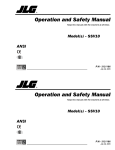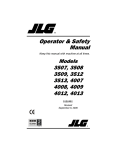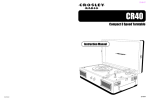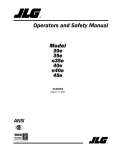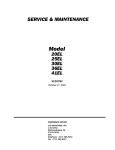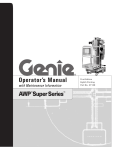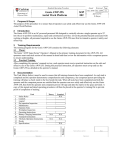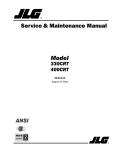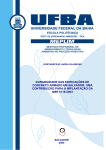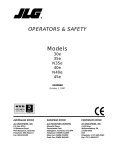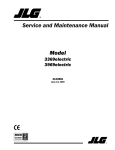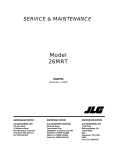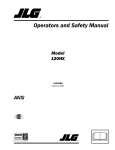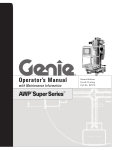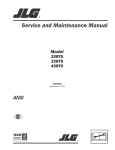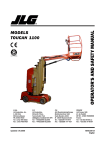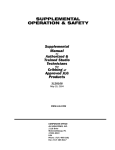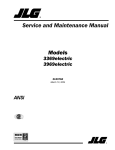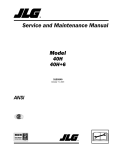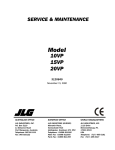Download Operation 3120781 01-17-02 ANSI English
Transcript
Operation and Safety Manual Keep this manual with the machine at all times. Model(s) EL Series 20EL 25EL 30EL 36EL 41EL P/N - 3120781 January 17, 2002 FOREWORD The purpose of this manual is to provide users with the operating procedures essential for the promotion of proper machine operation for its intended purpose. It is important to over-stress proper machine usage. All information in this manual should be READ and UNDERSTOOD before any attempt is made to operate the machine. YOUR OPERATING MANUAL IS YOUR MOST IMPORTANT TOOL - Keep it with the machine. REMEMBER ANY EQUIPMENT IS ONLY AS SAFE AS THE OPERATOR. BECAUSE THE MANUFACTURER HAS NO DIRECT CONTROL OVER MACHINE APPLICATION AND OPERATION, PROPER SAFETY PRACTICES ARE THE RESPONSIBILITY OF THE USER AND HIS OPERATING PERSONNEL. ALL INSTRUCTIONS IN THIS MANUAL ARE BASED ON THE USE OF THE MACHINE UNDER PROPER OPERATING CONDITIONS, WITH NO DEVIATIONS FROM THE ORIGINAL DESIGN. ALTERATION AND/ OR MODIFICATION OF THE MACHINE IS STRICTLY FORBIDDEN, WITHOUT WRITTEN APPROVAL FROM JLG INDUSTRIES, PER OSHA REGULATIONS. THIS "SAFETY ALERT SYMBOL" IS USED TO CALL ATTENTION TO POTENTIAL HAZARDS WHICH MAY LEAD TO SERIOUS INJURY OR DEATH IF IGNORED. Safety of personnel and proper use of the machine are of primary concern, DANGER, WARNING, CAUTION, IMPORTANT, INSTRUCTIONS and NOTE are inserted throughout this manual to emphasize these areas. They are defined as follows: DANGER INDICATES AN IMMINENTLY HAZARDOUS SITUATION WHICH, IF NOT AVOIDED WILL RESULT IN SERIOUS INJURY OR DEATH. WARNING INDICATES A POTENTIALLY HAZARDOUS SITUATION WHICH, IF NOT AVOIDED COULD RESULT IN SERIOUS INJURY OR DEATH. CAUTION INDICATES A POTENTIALLY HAZARDOUS SITUATION WHICH, IF NOT AVOIDED, MAY RESULT IN MINOR OR MODERATE INJURY. IT MAY ALSO BE USED TO ALERT AGAINST UNSAFE PRACTICES. IMPORTANT OR INSTRUCTIONS PROCEDURES ESSENTIAL FOR SAFE OPERATION AND WHICH, IF NOT FOLLOWED MAY RESULT IN A MALFUNCTION OR DAMAGE TO THE MACHINE. Also in this Manual "Notes:" are used to provide information of special interest. Other Publications Avaliable: Service and Manitenance Manual . . . . . . . . . 3120782 Illustrated Parts Manual . . . . . . . . . . . . . . . . . 3120783 JLG INDUSTRIES, INC. MAY HAVE ISSUED SAFETY RELATED BULLETINS FOR YOUR JLG PRODUCT. CONTACT JLG INDUSTRIES, INC. OR THE LOCAL AUTHORIZED JLG DISTRIBUTOR FOR INFORMATION CONCERNING SAFETY RELATED BULLETINS WHICH MAY HAVE BEEN ISSUED FOR YOUR JLG PRODUCT. ALL ITEMS REQUIRED BY THE SAFETY RELATED BULLETINS MUST BE COMPLETED ON THE AFFECTED JLG PRODUCT. Due to the continuous product improvements, JLG Industries, Inc. reserves the right to make specification changes without prior notification. Contact JLG Industries, Inc. for updated information. This page left intentionally blank. INTRODUCTION - OPERATION/SAFETY PRECAUTIONS INTRODUCTION - OPERATION/SAFETY PRECAUTIONS All procedures herein are based on the use of the machine under proper operating conditions, with no deviations from original design intent ... as per OSHA regulations. 5. Load limits specified by the manufacturer shall not be exceeded. 6. Instruction and warning placards must be legible. 7. Aerial lifts may be "field modified" for uses other than those intended by the manufacturer only if certified in writing by the manufacturer or an equivalent entity, such as a nationally recognized testing lab, to be in conformity to applicable OSHA safety regulations and to be at least as safe as it was prior to modification. READ & HEED! The ownership, use, service, and/or maintenance of this machine is subject to various federal, state and local laws and regulations. It is the responsibility of the owner/user to be knowledgeable of these laws and regulations and to comply with them. The most prevalent regulations of this type are the Federal OSHA Safety Regulations*. Listed below, in abbreviated form are some of the requirements of Federal OSHA regulations in effect as of the date of publication of this handbook. The listing of these requirements shall not relieve the owner/user of the responsibility and obligation to determine all applicable laws and regulations and their exact wording and requirements, and to comply with the requirements. Nor shall the listing of these requirements constitute an assumption of responsibility of liability on the part of JLG Industries, Inc. 1. Only trained and authorized operators shall be permitted to operate the aerial lift. 2. A malfunctioning lift shall be shut down until repaired. 3. The controls shall be plainly marked as to their function. 4. The controls shall be tested each day prior to use to determine that they are in safe operating condition. 3120781 8. Aerial lifts shall not be used near electric power lines unless the lines have been deenergized or adequate clearance is maintained (see OSHA 29 CFR 1910.67 and 1926.400). 9. Employees using aerial lifts shall be instructed how to recognize and avoid unsafe conditions and hazards. 10. Ground controls shall not be operated unless permission has been obtained from personnel in the platform, except in case of an emergency. 11. Regular inspection of the job site and aerial lift shall be performed by competent persons. 12. Personnel shall always stand on the floor of the platform, not on boxes, planks, railing or other devices for work positioning. *Applicable Federal OSHA regulations, as of the date of publication of this manual include, but are not limited to, 29 CFR 1910.67, 29 CFR 1926.20, 29 CFR 1926.21, 29 CFR 1926.28, 29 CFR 1926.400 and 29 CFR 1926.453. Consult the current regulations for the exact wording and full text of the requirements and contact the closest Federal OSHA office for specific interpretations. – JLG Lift – a INTRODUCTION - MAINTENANCE SAFETY PRECAUTIONS INTRODUCTION - MAINTENANCE SAFETY PRECAUTIONS A. GENERAL C. MAINTENANCE This section contains the general safety precautions which must be observed during maintenance of the aerial platform. It is of utmost importance that maintenance personnel pay strict attention to these warnings and precautions to avoid possible injury to themselves or others or damage to the equipment. A maintenance program must be established by a qualified person and must be followed to ensure that the machine is safe to operate. MODIFICATION OF THE MACHINE WITHOUT APPROVAL OF JLG INDUSTRIES, OR CERTIFICATION BY A NATIONALLY RECOGNIZED TESTING LAB TO BE IN CONFORMITY WITH APPLICABLE OSHA REGULATIONS, AND TO BE AT LEAST AS SAFE AS BEFORE MODIFICATION, IS PROHIBITED AND IS A VIOLATION OF OSHA RULES. The specific precautions to be observed during machine maintenance are inserted at the appropriate point in the manual. These precautions are, for the most part, those that apply when servicing hydraulic and larger machine component parts. Your safety, and that of others, is the first consideration when engaging in the maintenance of equipment. Always be conscious of component weight and never attempt to move heavy parts without the aid of a mechanical device. Do not allow heavy objects to rest in an unstable position. When raising a portion of the equipment, ensure that adequate support is provided. SINCE THE MACHINE MANUFACTURER HAS NO DIRECT CONTROL OVER THE FIELD INSPECTION AND MAINTENANCE, SAFETY IN THIS AREA IS THE RESPONSIBILITY OF THE OWNER/ OPERATOR. FAILURE TO COMPLY WITH SAFETY PRECAUTIONS LISTED IN THIS SECTION COULD RESULT IN MACHINE DAMAGE, PERSONNEL INJURY OR DEATH AND IS A SAFETY VIOLATION. • REMOVE ALL RINGS, WATCHES, AND JEWELRY WHEN PERFORMING ANY MAINTENANCE. • DO NOT WEAR LONG HAIR UNRESTRAINED, OR LOOSE FITTING CLOTHING AND NECKTIES WHICH ARE APT TO BECOME CAUGHT ON OR ENTANGLED IN EQUIPMENT. • OBSERVE AND OBEY ALL DANGER, WARNING, CAUTION AND OTHER INSTRUCTIONS ON MACHINE AND IN SERVICE MANUAL. • KEEP STANDING SURFACES AND HAND HOLDS FREE OF OIL, GREASE, WATER, ETC. • NEVER WORK UNDER AN ELEVATED PLATFORM UNTIL PLATFORM HAS BEEN SAFELY RESTRAINED FROM ANY MOVEMENT BY BLOCKING OR OVERHEAD SLING. • BEFORE MAKING ADJUSTMENTS, LUBRICATING OR PERFORMING ANY OTHER MAINTENANCE, SHUT OFF ALL POWER CONTROLS. • BATTERY SHOULD ALWAYS BE DISCONNECTED DURING REPLACEMENT OF ELECTRICAL COMPONENTS. • KEEP ALL SUPPORT EQUIPMENT AND ATTACHMENTS STOWED IN THEIR PROPER PLACE. • USE ONLY APPROVED, NONFLAMMABLE CLEANING SOLVENTS. B. HYDRAULIC SYSTEM SAFETY 1. It should be particularly noted that the machines hydraulic systems operate at extremely high and potentially dangerous pressures. Every effort should be made to relieve any system pressure prior to disconnecting or removing any portion of the system. 2. Relieve system pressure by activating the lift DOWN control with the platform completely lowered to direct any line pressure back into the return line to the reservoir. Pressure feed lines to system components can then be disconnected with minimal fluid loss. b – JLG Lift – 3120781 EFFECTIVITY PAGE EFFECTIVITY CHANGES June 15, 1999 - Original Issue of Manual April 20, 2000 – Revised – Added Proposition 65 to front of manual. January 17, 2002 – Manual Revised 3120781 – JLG Lift – c EFFECTIVITY PAGE This Page Left Intentionally Blank d – JLG Lift – 3120781 TABLE OF CONTENTS SUBJECT - SECTION, PARAGRAPH PAGE NO. INTRODUCTION - OPERATION/SAFETY PRECAUTIONS. . . . . . . . . . . . . . . . . . . . . . . . . . . . . . . . . . . .a INTRODUCTION - MAINTENANCE SAFETY PRECAUTIONS. . . . . . . . . . . . . . . . . . . . . . . . . . . . . . . . . .b A B C General . . . . . . . . . . . . . . . . . . . . . . . . . . . . . . . . . . . . . . . . . . . . . . . . . . . . . . . . . . . . . . . . . . . . . .b Hydraulic System Safety . . . . . . . . . . . . . . . . . . . . . . . . . . . . . . . . . . . . . . . . . . . . . . . . . . . . . . . . .b Maintenance . . . . . . . . . . . . . . . . . . . . . . . . . . . . . . . . . . . . . . . . . . . . . . . . . . . . . . . . . . . . . . . . . .b EFFECTIVITY CHANGES . . . . . . . . . . . . . . . . . . . . . . . . . . . . . . . . . . . . . . . . . . . . . . . . . . . . . . . . . . . . . .c SECTION 1 - SAFETY PRECAUTIONS 1.1 1.2 1.3 1.4 1.5 1.6 General . . . . . . . . . . . . . . . . . . . . . . . . . . . . . . . . . . . . . . . . . . . . . . . . . . . . . . . . . . . . . . . . . . . . . .1-1 Electrocution Hazard. . . . . . . . . . . . . . . . . . . . . . . . . . . . . . . . . . . . . . . . . . . . . . . . . . . . . . . . . . . .1-1 Transporting . . . . . . . . . . . . . . . . . . . . . . . . . . . . . . . . . . . . . . . . . . . . . . . . . . . . . . . . . . . . . . . . . .1-1 Transport Safety . . . . . . . . . . . . . . . . . . . . . . . . . . . . . . . . . . . . . . . . . . . . . . . . . . . . . . . . . . . . . . .1-2 Pre-Operational Safety . . . . . . . . . . . . . . . . . . . . . . . . . . . . . . . . . . . . . . . . . . . . . . . . . . . . . . . . . .1-3 Operating Safety . . . . . . . . . . . . . . . . . . . . . . . . . . . . . . . . . . . . . . . . . . . . . . . . . . . . . . . . . . . . . . .1-4 SECTION 2 - PREPARATION AND INSPECTION 2.1 2.2 2.3 2.4 2.5 2.6 2.7 General . . . . . . . . . . . . . . . . . . . . . . . . . . . . . . . . . . . . . . . . . . . . . . . . . . . . . . . . . . . . . . . . . . . . . .2-1 Preparation For Use . . . . . . . . . . . . . . . . . . . . . . . . . . . . . . . . . . . . . . . . . . . . . . . . . . . . . . . . . . . .2-1 Delivery And Frequent Inspection. . . . . . . . . . . . . . . . . . . . . . . . . . . . . . . . . . . . . . . . . . . . . . . . . .2-1 Daily Walk-around Inspection . . . . . . . . . . . . . . . . . . . . . . . . . . . . . . . . . . . . . . . . . . . . . . . . . . . . .2-2 Daily Functional Check . . . . . . . . . . . . . . . . . . . . . . . . . . . . . . . . . . . . . . . . . . . . . . . . . . . . . . . . . .2-4 Torque Requirements . . . . . . . . . . . . . . . . . . . . . . . . . . . . . . . . . . . . . . . . . . . . . . . . . . . . . . . . . . .2-4 Battery Charging & Maintenance (EL-DC Models Only) . . . . . . . . . . . . . . . . . . . . . . . . . . . . . . . .2-5 SECTION 3 - USER RESPONSIBILITIES & MACHINE CONTROLS 3.1 3.2 3.3 3.4 General . . . . . . . . . . . . . . . . . . . . . . . . . . . . . . . . . . . . . . . . . . . . . . . . . . . . . . . . . . . . . . . . . . . . . .3-1 Personnel Training . . . . . . . . . . . . . . . . . . . . . . . . . . . . . . . . . . . . . . . . . . . . . . . . . . . . . . . . . . . . .3-1 Operating Characteristics And Limitations . . . . . . . . . . . . . . . . . . . . . . . . . . . . . . . . . . . . . . . . . . .3-2 Controls And Indicators. . . . . . . . . . . . . . . . . . . . . . . . . . . . . . . . . . . . . . . . . . . . . . . . . . . . . . . . . .3-2 SECTION 4 - MACHINE OPERATION 4.1 4.2 4.3 4.4 4.5 4.6 Machine Description . . . . . . . . . . . . . . . . . . . . . . . . . . . . . . . . . . . . . . . . . . . . . . . . . . . . . . . . . . . .4-1 General . . . . . . . . . . . . . . . . . . . . . . . . . . . . . . . . . . . . . . . . . . . . . . . . . . . . . . . . . . . . . . . . . . . . . .4-1 Machine Set-up And Operation. . . . . . . . . . . . . . . . . . . . . . . . . . . . . . . . . . . . . . . . . . . . . . . . . . . .4-2 Quick-Change Platform. . . . . . . . . . . . . . . . . . . . . . . . . . . . . . . . . . . . . . . . . . . . . . . . . . . . . . . . . .4-4 Stowing Machine . . . . . . . . . . . . . . . . . . . . . . . . . . . . . . . . . . . . . . . . . . . . . . . . . . . . . . . . . . . . . . .4-4 Transporting And Lifting . . . . . . . . . . . . . . . . . . . . . . . . . . . . . . . . . . . . . . . . . . . . . . . . . . . . . . . . .4-4 SECTION 5 - OPTIONAL EQUIPMENT 5.1 5.2 5.3 Optional Equipment . . . . . . . . . . . . . . . . . . . . . . . . . . . . . . . . . . . . . . . . . . . . . . . . . . . . . . . . . . . .5-1 Am-SE - Straddle Extension Kit – Installation . . . . . . . . . . . . . . . . . . . . . . . . . . . . . . . . . . . . . . . . .5-2 Am-SE - Straddle Extension Kit – Set-up And Operation . . . . . . . . . . . . . . . . . . . . . . . . . . . . . . . .5-4 SECTION 6 - EMERGENCY PROCEDURES 6.1 6.2 6.3 6.4 General Information. . . . . . . . . . . . . . . . . . . . . . . . . . . . . . . . . . . . . . . . . . . . . . . . . . . . . . . . . . . . .6-1 Emergency Controls And Their Locations . . . . . . . . . . . . . . . . . . . . . . . . . . . . . . . . . . . . . . . . . . .6-1 Emergency Operation . . . . . . . . . . . . . . . . . . . . . . . . . . . . . . . . . . . . . . . . . . . . . . . . . . . . . . . . . . .6-1 Incident Notification. . . . . . . . . . . . . . . . . . . . . . . . . . . . . . . . . . . . . . . . . . . . . . . . . . . . . . . . . . . . .6-2 SECTION 7 - INSPECTION AND REPAIR LOG 3120781 – JLG Lift – i TABLE OF CONTENTS (Continued) FIGURE NO. 1-1. 1-2. 1-3. 1-4. 1-5. 1-6. 1-7. 1-8. 1-9. 1-10. 2-1. 2-2. 2-3. 2-4. 2-5. 2-6. 3-1. 3-2. 3-3. 3-4. 3-5. 3-6. 3-7. 3-8. 4-1. 4-2. 4-3. 4-4. 4-5. 4-6. 4-7. 5-1. 5-2. 5-3. 5-4. ii PAGE NO. Electrocution Hazard. . . . . . . . . . . . . . . . . . . . . . . . . . . . . . . . . . . . . . . . . . . . . . . . . . . . . . . . . . . .1-1 Use Handles Provided On Mast Crossbar To Move Machine.. . . . . . . . . . . . . . . . . . . . . . . . . . . .1-2 Do Not Move Unit on Soft or Uneven Surfaces or Over Obstructions, Bumps, Debris, Etc.. . . . .1-2 Two People May Be Required on Slopes Up To Five Degrees. Also Always Travel With Platform End On The Low Side of Slope. . . . . . . . . . . . . . . . . . . . . . . . .1-3 Read Your Manual. . . . . . . . . . . . . . . . . . . . . . . . . . . . . . . . . . . . . . . . . . . . . . . . . . . . . . . . . . . . . .1-3 Always Look in the Direction of Movement. Watch for Overhead and Other Obstructions. . . . . .1-4 Death or Serious Injury Could Occur from a Tip Over . . . . . . . . . . . . . . . . . . . . . . . . . . . . . . . . . .1-4 All Personnel Must Stand Clear When Platform Is Being Raised Or Lowered. . . . . . . . . . . . . . . .1-5 Falling from Platform could cause Death or Serious Injury.. . . . . . . . . . . . . . . . . . . . . . . . . . . . . .1-5 Be Sure Area On Tilt Back Side And Under Tilt Back Arm Is Clear Of Personnel And/Or Obstructions Prior To Using Tilt Back. . . . . . . . . . . . . . . . . . . . . . . . . . . . . . . . . . . . . . . . .1-6 Daily Walk-Around Inspection. . . . . . . . . . . . . . . . . . . . . . . . . . . . . . . . . . . . . . . . . . . . . . . . . . . . .2-3 Battery Fluid Level. . . . . . . . . . . . . . . . . . . . . . . . . . . . . . . . . . . . . . . . . . . . . . . . . . . . . . . . . . . . . .2-5 Battery Box and Charger Assembly. (D.C. Model Only) . . . . . . . . . . . . . . . . . . . . . . . . . . . . . . . .2-5 Dual Voltage Battery Charger - Front Panel. . . . . . . . . . . . . . . . . . . . . . . . . . . . . . . . . . . . . . . . . .2-6 Lubrication Locations (See Table below). . . . . . . . . . . . . . . . . . . . . . . . . . . . . . . . . . . . . . . . . . . .2-7 Torque Chart. . . . . . . . . . . . . . . . . . . . . . . . . . . . . . . . . . . . . . . . . . . . . . . . . . . . . . . . . . . . . . . . . .2-8 Ground Control Station. . . . . . . . . . . . . . . . . . . . . . . . . . . . . . . . . . . . . . . . . . . . . . . . . . . . . . . . . .3-2 Manual Descent Valve Location.. . . . . . . . . . . . . . . . . . . . . . . . . . . . . . . . . . . . . . . . . . . . . . . . . . .3-3 Platform Control Station. . . . . . . . . . . . . . . . . . . . . . . . . . . . . . . . . . . . . . . . . . . . . . . . . . . . . . . . . .3-3 Decal Locations (Front View) . . . . . . . . . . . . . . . . . . . . . . . . . . . . . . . . . . . . . . . . . . . . . . . . . . . . .3-4 Decal Locations (1703778 decal from Front View). . . . . . . . . . . . . . . . . . . . . . . . . . . . . . . . . . . . .3-5 Decal Locations (Rear View) . . . . . . . . . . . . . . . . . . . . . . . . . . . . . . . . . . . . . . . . . . . . . . . . . . . . . .3-6 Decal Locations (Top View) . . . . . . . . . . . . . . . . . . . . . . . . . . . . . . . . . . . . . . . . . . . . . . . . . . . . . .3-7 Decal Locations (Right/Left View) . . . . . . . . . . . . . . . . . . . . . . . . . . . . . . . . . . . . . . . . . . . . . . . . . .3-8 Outrigger Components Installed. . . . . . . . . . . . . . . . . . . . . . . . . . . . . . . . . . . . . . . . . . . . . . . . . . .4-2 Quick Change Platform Mount.. . . . . . . . . . . . . . . . . . . . . . . . . . . . . . . . . . . . . . . . . . . . . . . . . . . .4-4 Tilt-Back Assembly Set-Up.. . . . . . . . . . . . . . . . . . . . . . . . . . . . . . . . . . . . . . . . . . . . . . . . . . . . . . .4-6 Loading Machine onto Bed of Pick-Up Truck. . . . . . . . . . . . . . . . . . . . . . . . . . . . . . . . . . . . . . . . .4-8 EL Tie Down Procedure. . . . . . . . . . . . . . . . . . . . . . . . . . . . . . . . . . . . . . . . . . . . . . . . . . . . . . . . . .4-9 EL Machine Tie-Down - Method 1. (Typical Flat Bed Truck) . . . . . . . . . . . . . . . . . . . . . . . . . . . . .4-10 EL Machine Tie-Down - Method 2 (Typical Flat Bed Truck) . . . . . . . . . . . . . . . . . . . . . . . . . . . . . .4-10 SE-Adapter - Wiring Kit Hole Locations for Grommet & Spring Clips (Same For Both Sides) . . .5-2 Straddle Adapter Wiring Harness to AM/EL Wiring Connections. . . . . . . . . . . . . . . . . . . . . . . . . .5-3 Straddle Extension Component Assembly. . . . . . . . . . . . . . . . . . . . . . . . . . . . . . . . . . . . . . . . . . .5-5 Lowering AM/EL Machine on Straddle Unit - Side Lifting Rail - Quick Release Pins. . . . . . . . . . .5-6 TABLE NO. 1-1 2-1 4-1 4-2 7-1 TITLE TITLE PAGE NO. Minimum Safe Approach Distance (to energized power lines or parts) . . . . . . . . . . . . . . . . . . . .1-1 Lubrication Intervals for Various Components . . . . . . . . . . . . . . . . . . . . . . . . . . . . . . . . . . . . . . . .2-7 Maximum Platform Capacity. (Standard Platform) . . . . . . . . . . . . . . . . . . . . . . . . . . . . . . . . . . . . .4-3 EL Machine Gross Weights. . . . . . . . . . . . . . . . . . . . . . . . . . . . . . . . . . . . . . . . . . . . . . . . . . . . . . .4-9 Inspection and Repair Log . . . . . . . . . . . . . . . . . . . . . . . . . . . . . . . . . . . . . . . . . . . . . . . . . . . . . . .7-1 – JLG Lift – 3120781 SECTION 1 - SAFETY PRECAUTIONS SECTION 1. SAFETY PRECAUTIONS 1.1 Table 1-1. GENERAL Minimum Safe Approach Distance (to energized power lines or parts) This section prescribes the proper and safe practices for major areas of machine usage which have been divided into three basic categories: Transporting, Pre-Operation and Operation. In order to promote proper usage of the machine, it is mandatory that a daily routine be established based on instruction given in this section. A maintenance program must also be established by a qualified person and must be followed to ensure that the machine is safe to operate. VOLTAGE RANGE (PHASE TO PHASE) The user/operator of the machine should not accept operating responsibility until this manual has been READ and UNDERSTOOD, and operating instructions of the machine under the supervision of an experienced and qualified operator, has been completed. If there is a question on application and/or operation, JLG Industries Product Safety and Reliability should be consulted. MINIMUM SAFE DISTANCE Feet [m] 0-300V – Avoid Contact Over 300V to 50KV – 10 ft. [3 m] Over 50KV to 200KV – 15 ft. [4.6 m] Over 200KV to 350KV – 20 ft. [6 m] Over 350KV to 500KV – 25 ft. [7.6 m] Over 500KV to 750KV – 35 ft. [10.6 m] Over 750KV to 1000KV – 45 ft. [13.7 m] MODIFICATION OF THE MACHINE WITHOUT APPROVAL OF JLG INDUSTRIES, OR CERTIFICATION BY A NATIONALLY RECOGNIZED TESTING LAB TO BE IN CONFORMITY WITH APPLICABLE OSHA REGULATIONS, AND TO BE AT LEAST AS SAFE AS BEFORE MODIFICATION, IS PROHIBITED AND IS A VIOLATION OF OSHA RULES. Figure 1-1. Electrocution Hazard. 1.2 ELECTROCUTION HAZARD Minimum safe approach distances (M.S.A.D.) to energized (exposed or insulated) power lines and parts. 1.3 TRANSPORTING Before transporting the machine the user/operator must be familiar with the proper procedures for transporting the machine, as well as the weight and size of the machine. DO NOT MANEUVER MACHINE OR PERSONNEL TO DISTANCE LESS THAN M.S.A.D (SEE TABLE 1-1.). ASSUME ALL ELECTRICAL PARTS AND WIRING ARE ENERGIZED UNLESS KNOWN OTHERWISE. The user/operator should be familiar with the surrounding work area and surface before transporting the machine. The work area must be a smooth, firm surface on which machine is capable of being leveled. THIS MACHINE DOES NOT PROVIDE PROTECTION FROM CONTACT WITH OR PROXIMITY TO AN ELECTRICALLY CHARGED CONDUCTOR. MAINTAIN A CLEARANCE OF AT LEAST 10 FT. (3M) BETWEEN ANY PART OF THE MACHINE AND ANY ELECTRICAL LINE OR APPARATUS CARRYING UP TO 50,000 VOLTS. 1 FT. (0.3M) ADDITIONAL CLEARANCE IS REQUIRED FOR EVERY ADDITIONAL 30,000 VOLTS OR LESS. ALLOW FOR PLATFORM SWAY, ROCK OR SAG AND ELECTRICAL LINE SWAYING, (SEE FOLLOWING TABLE). NOTE: Remember that the key to safe and proper usage is common sense and its careful application. 3120781 FAILURE TO COMPLY WITH SAFETY PRECAUTIONS LISTED IN THIS SECTION AND ON MACHINE MAY RESULT IN MACHINE DAMAGE, PERSONNEL INJURY OR DEATH AND IS A SAFETY VIOLATION. – JLG Lift – 1-1 SECTION 1 - SAFETY PRECAUTIONS 1.4 TRANSPORT SAFETY • COMPLETELY EMPTY PLATFORM OF TOOLS AND DEBRIS BEFORE MOVING MACHINE. • FULLY LOWER PLATFORM, REMOVE AND STOW OUTRIGGERS WHILE MACHINE IS BEING MOVED. • NEVER ALLOW PERSONNEL IN PLATFORM WHILE MOVING MACHINE. FAILURE TO OBSERVE THE FOLLOWING TIPPING HAZARD INSTRUCTIONS COULD CAUSE THE UNIT TO TIP OVER OR BE HARD TO CONTROL WHEN BEING MOVED, WHICH COULD RESULT IN SERIOUS INJURY OR DEATH DUE TO BEING PINNED OR CRUSHED BY THE UNIT. • ON A LEVEL SURFACE, ALWAYS TRAVEL WITH THE PLATFORM END LEADING THE WAY. • WATCH FOR OBSTRUCTIONS AROUND MACHINE AND OVERHEAD WHEN MOVING. • CHECK TRAVEL PATH FOR PERSONS, HOLES, BUMPS, DROP-OFFS, OBSTRUCTIONS, DEBRIS, AND COVERINGS WHICH MAY CONCEAL HOLES AND OTHER HAZARDS, AS TIPPING COULD OCCUR. • BEFORE MOVING MACHINE ON FLOORS, TRUCKS A N D O T H E R S UR FA C E S , C H E C K A L LO WA B L E CAPACITY OF SURFACES. • TWO PEOPLE ARE REQUIRED ON SLOPES UP TO 5 DEGREES. A FORKLIFT MUST BE USED WHEN MOVING UNITS ON SLOPES GREATER THAN 5 DEGREES. Figure 1-3. Do Not Move Unit on Soft or Uneven Surfaces or Over Obstructions, Bumps, Debris, Etc. • ALWAYS TRAVEL UP OR DOWN A SLOPE WITH THE PLATORM END OF THE MACHINE POSITIONED TOWARDS THE LOW SIDE OF THE SLOPE. THE OPERATOR AND ASSISTANT MUST WALK BESIDE AND GUIDE THE MACHINE WITH THE HANDLES ON THE MAST CROSSBAR. • NEVER POSITION THE UNIT SIDEWAYS ON A SLOPE. • USE CAUTION AND CHECK CLEARANCES WHEN MOVING MACHINE IN RESTRICTED OR CLOSE QUARTERS. • ALWAYS USE AN ASSISTANT WHEN MOVING MACHINE IN AREAS WHERE VISION IS OBSTRUCTED. • KEEP NON-OPERATING PERSONNEL AT LEAST 6 FEET (1.8 M) AWAY FROM MACHINE DURING TRANSPORTING OPERATIONS. Figure 1-2. Use Handles Provided On Mast Crossbar To Move Machine. 1-2 – JLG Lift – 3120781 SECTION 1 - SAFETY PRECAUTIONS Figure 1-4. Two People May Be Required on Slopes Up To Five Degrees. Also Always Travel With Platform End On The Low Side of Slope. 1.5 • BEFORE OPERATION CHECK WORK AREA FOR MACHINE TRAFFIC SUCH AS FORKLIFTS, CRANES, AND OTHER CONSTRUCTION EQUIPMENT. PRE-OPERATIONAL SAFETY • SET-UP MACHINE FOR OPERATION ONLY ON A SMOOTH, FIRM SURFACE ON WHICH THE MACHINE IS CAPABLE OF BEING LEVELED. • ENSURE THAT OPERATORS OF OTHER OVERHEAD AND FLOOR LEVEL MACHINES ARE AWARE OF THE AERIAL PLATFORMS PRESENCE. DISCONNECT POWER TO OVERHEAD CRANES. BARRICADE FLOOR AREA IF NECESSARY. • PRECAUTIONS TO AVOID ALL KNOWN HAZARDS IN THE WORK AREA MUST BE TAKEN BY THE OPERATOR AND HIS SUPERVISOR BEFORE STARTING THE WORK. Figure 1-5. Read Your Manual. • READ YOUR MANUAL. UNDERSTAND WHAT YOU’VE READ - THEN BEGIN OPERATIONS. • ALLOW ONLY THOSE AUTHORIZED AND QUALIFIED PERSONNEL TO OPERATE MACHINE WHO HAVE DEMONSTRATED THAT THEY UNDERSTAND SAFE AND PROPER OPERATION AND MAINTENANCE OF THE UNIT. • AN OPERATOR MUST NOT ACCEPT OPERATING RESPONSIBILITIES UNTIL ADEQUATE TRAINING HAS BEEN GIVEN BY COMPETENT AND AUTHORIZED PERSONS. • BEFORE OPERATION CHECK WORK AREA FOR OVERHEAD ELECTRIC LINES. (SEE ELECTROCUTION HAZARD, SECTION 1-2.) 3120781 • DO NOT OPERATE THIS MACHINE UNLESS IT HAS BEEN SERVICED AND MAINTAINED ACCORDING TO THE MANUFACTURERS SPECIFICATIONS AND SCHEDULE. • ENSURE DAILY INSPECTION AND FUNCTION CHECK IS PERFORMED PRIOR TO PLACING MACHINE INTO OPERATION. HAVE AUTHORIZED PERSONNEL TAKE ANY NECESSARY CORRECTIVE ACTION BEFORE PLACING MACHINE INTO OPERATION. • NEVER DISABLE OR MODIFY ANY SAFETY DEVICE. ANY MODIFICATION OF THE MACHINE IS A SAFETY VIOLATION AND IS A VIOLATION OF OSHA AND ANSI RULES. • DO NOT OPERATE MACHINE WHEN EXPOSED TO HIGH WIND, RAIN OR SNOW. – JLG Lift – 1-3 SECTION 1 - SAFETY PRECAUTIONS • NEVER OPERATE OR RAISE PLATFORM WHEN MACHINE IS ON A TRUCK OR OTHER VEHICLE. • APPROVED HEAD GEAR (I.E. HARD HAT, ETC.) MUST BE WORN WHEN REQUIRED BY ALL OPERATING AND GROUND PERSONNEL. • READ AND OBEY ALL DANGER, WARNINGS, CAUT I O N S A N D O P E R AT I N G I N S T R U C T I O N S O N MACHINE AND IN THIS MANUAL. • BE FAMILIAR WITH LOCATION AND OPERATION OF GROUND STATION AND EMERGENCY CONTROLS. 1.6 OPERATING SAFETY • DO NOT OPERATE ANY MACHINE ON WHICH DANGER, WARNING, CAUTION OR INSTRUCTION PLACARDS OR DECALS ARE MISSING OR ILLEGIBLE. • NEVER EXCEED MANUFACTURERS RATED PLATFORM CAPACITY - REFER TO CAPACITY DECAL ON MACHINE. • OPERATE AC UNITS WITH AN EXTENSION CORD WIRE RATED AT A MINIMUM OF 15 AMPS. • THE MACHINE IS EQUIPPED WITH AN OUTRIGGER INTERLOCK SYSTEM THAT WILL NOT ALLOW THE PLATFORM TO BE RAISED UNLESS ALL FOUR OUTRIGGERS ARE PROPERLY INSTALLED AND MACHINE IS LEVELED. Figure 1-7. Death or Serious Injury Could Occur from a Tip Over AND ALL WHEELS ARE COMPLETELY OFF THE GROUND. • DO NOT OPERATE MACHINE ON SOFT FOOTING THAT WILL ALLOW LEVELING JACKS TO SETTLE INTO OR BREAK THROUGH SURFACE. • NEVER OPERATE A MALFUNCTIONING MACHINE. IF A MALFUNCTION OCCURS, SHUT DOWN THE MACHINE, REMOVE IT FROM SERVICE, AND NOTIFY PROPER AUTHORITIES. Figure 1-6. Always Look in the Direction of Movement. Watch for Overhead and Other Obstructions. • DO NOT ENTER PLATFORM UNTIL ALL LEVELING JACKS HAVE BEEN PROPERLY ADJUSTED AND THE UNIT’S BASE FRAME IS LEVEL ACCORDING TO THE BUBBLE LEVELING INDICATOR ON BASE FRAME, 1-4 • WHEN APPLICABLE BY REASON OF LOCAL REGULATIONS OR JOBSITE/EMPLOYER SAFETY RULES, PERSONNEL IN THE PLATFORM SHALL AT ALL TIMES WEAR APPROVED FALL PROTECTION DEVICES OTHER SAFETY GEAR AS REQUIRED. A LANYARD ATTACHMENT IS SUPPLIED ON THE SIDE OF THE MACHINE’S MAST. – JLG Lift – 3120781 SECTION 1 - SAFETY PRECAUTIONS Figure 1-9. Falling from Platform could cause Death or Serious Injury. Figure 1-8. All Personnel Must Stand Clear When Platform Is Being Raised Or Lowered. • CHECK CLEARANCES ABOVE, ON SIDES AND BOTTOM OF PLATFORM WHEN RAISING AND LOWERING PLATFORM. • NEVER USE THE MAST TO GAIN ACCESS TO OR LEAVE PLATFORM. • DO NOT ATTACH OVERHANGING LOADS TO THE PLATFORM OR INCREASE THE PLATFORM SIZE WITH UNAUTHORIZED DECK EXTENSIONS OR ATTACHMENTS. • DO NOT TIE OFF MACHINE TO ANY ADJACENT STRUCTURE. NEVER ATTACH WIRE, CABLE OR ANY SIMILAR ITEMS TO PLATFORM. • TRANSFERS BETWEEN A STRUCTURE AND THE PLATFORM EXPOSE OPERATORS TO FALL POTENTIALS. THIS PRACTICE SHOULD BE DISCOURAGED WHEREVER POSSIBLE. WHERE TRANSFER MUST BE ACCOMPLISHED TO PERFORM THE JOB, TWO LANYARDS WILL BE USED AND THE PLATFORM MUST BE WITHIN 1 FOOT (0.3 M) OF THE ADJACENT - SAFE AND SECURE - STRUCTURE. ONE LANYARD SHOULD BE ATTACHED TO THE PLATFORM, THE OTHER TO THE STRUCTURE. THE SAFETY LANYARD THAT IS ATTACHED TO THE PLATFORM SHOULD NOT BE DISCONNECTED UNTIL SUCH TIME AS THE TRANSFER TO THE STRUCTURE IS COMPLETE. • DURING PLATFORM OPERATION KEEP ALL BODY PARTS INSIDE PLATFORM RAILINGS. • NEVER POSITION LADDERS, STEPS, OR SIMILAR ITEMS ON UNIT TO PROVIDE ADDITIONAL REACH FOR ANY PURPOSE. • WHEN WORKING FROM PLATFORM BOTH FEET MUST BE FIRMLY POSITIONED ON DECK. • DO NOT EXTEND REACH LIMITS OF THIS MACHINE WITH ADDITIONAL EQUIPMENT SUCH AS PLANKS, BOXES, ETC. • DO NOT USE LADDERS ON OR AGAINST MACHINE. DO NOT PERFORM WORK THAT WILL SUBJECT UNIT TO A HORIZONTAL FORCE OR CREATE A ROCKING MOTION OF THE PLATFORM. • DO NOT OPERATE MACHINE FROM PLATFORM WITHOUT THE PLATFORM GATE IN PLACE AND PROPERLY CLOSED. THIS IS A SAFETY VIOLATION. • ALWAYS ENSURE THAT POWER TOOLS ARE PROPERLY STOWED AND NEVER LEFT HANGING BY THEIR CORD FROM THE PLATFORM WORK AREA. • AVOID ACCUMULATION OF DEBRIS ON PLATFORM WORK AREA. KEEP MUD, OIL, GREASE AND OTHER SLIPPERY SUBSTANCES FROM FOOTWEAR AND PLATFORM DECK. • NO HORSEPLAY IS PERMITTED IN PLATFORM. • DO NOT ALLOW PERSONNEL TO TAMPER WITH, SERVICE, OR OPERATE THIS MACHINE FROM THE GROUND WITH PERSONNEL IN PLATFORM EXCEPT IN AN EMERGENCY.. 3120781 – JLG Lift – 1-5 SECTION 1 - SAFETY PRECAUTIONS Tilt Back Assembly - Set-up Safety (EL36 & EL41 Machines Only) • REMOVE ALL TOOLS OR DEBRIS FROM PLATFORM BEFORE TILTING MACHINE INTO THE TILT BACK POSITION. • STOW ALL OUTRIGGERS. • ONLY TILT MACHINE BACK TO TILTED POSITION ON A FLAT, FIRM AND LEVEL SURFACE. Figure 1-10. Be Sure Area On Tilt Back Side And Under Tilt Back Arm Is Clear Of Personnel And/Or Obstructions Prior To Using Tilt Back. 1-6 – JLG Lift – 3120781 SECTION 2 - PREPARATION AND INSPECTION SECTION 2. PREPARATION AND INSPECTION 2.1 GENERAL 2.3 This section provides the necessary information needed by those personnel that are responsible to place the machine in operation readiness, and lists checks that are performed prior to use of the machine. It is important that the information contained in this section be read and understood before any attempt is made to operate the machine. Ensure that all the necessary inspections have been completed successfully before placing the machine into service. These procedures will aid in obtaining maximum service life and safe operation. SINCE THE MACHINE MANUFACTURER HAS NO DIRECT CONTROL OVER THE FIELD INSPECTION AND MAINTENANCE, THIS IS THE RESPONSIBILITY OF THE OWNER/OPERATOR. DELIVERY AND FREQUENT INSPECTION The following check list provides a systematic inspection to assist in detecting defective, damaged, or improperly installed parts. The check list denotes the items to be inspected and conditions to examine. Frequent inspection shall be performed every three (3) months or more often when required by environment, severity, and frequency of usage. Platform Guard Rail Assemblies Properly installed; no loose or missing parts; no visible damage. Platform Assembly No visible damage; free of dirt and debris. Platform gate or slide bar functions properly on machines so equipped. Mast 2.2 PREPARATION FOR USE Before a new machine is put into operation it must be carefully inspected for any evidence of damage resulting from shipment and inspected periodically thereafter, as outlined in Section 2-3, Delivery and Periodic Inspection. The unit should be thoroughly checked for hydraulic leaks during initial start-up and run. A check of all components should be made to assure their security. All preparation necessary to place the machine in operation readiness status are the responsibility of management personnel. Preparation requires good common sense, (i.e. lift works smoothly) coupled with a series of visual inspections. The mandatory requirements are given in Section 2-4, Daily Walk Around Inspection. It should be assured that the items appearing in the Delivery and Frequent Inspection and Functional Check are complied with prior to putting the machine into service. NOTE: This machine requires periodic safety and maintenance inspections. An annual inspection shall be performed on the aerial platform no later than thirteen (13) months from the date of the new machine inspection or prior annual inspection. No visible damage, abrasions and/or distortions; no binding; mast sections free of dirt or other foreign material. Sequencing cables properly secured; no visible damage; proper cable tension. Mast Chains & Cables No visible damage; proper chain/cable tension; evidence of proper lubrication. Chain/cable sheaves and sheave pins properly secured; no visible damage. Control/(Power) Cable(s) for Platform No visible damage; cable properly tensioned and seated in control cable sheaves; control cable sheaves not damaged and rotating freely. Lift Cylinder No rust, nicks, scratches or foreign material on piston rod. No leakage. Manual Descent Valve secure; no visible damage. Frame No visible damage; loose or missing hardware (top and underside); outrigger sockets not bent or damaged; outrigger beam locking pins properly secured; outrigger interlock LED’s properly secured and undamaged. Wheels and Casters Free rolling; no loose or missing parts; no visible damage. 3120781 – JLG Lift – 2-1 SECTION 2 - PREPARATION AND INSPECTION Hydraulic Oil Supply conditions which could cause extensive machine damage. Check the hydraulic oil level at the hydraulic fluid reservoir through the access hole on the side of the ground control panel. Maintain an oil level to the "Fill to Line" indicator on the side of the reservoir. 1. Wheels and Casters - Properly secured, wheels and casters turn freely and are properly lubricated. Check for any visible damage. If fluid level is low, see Service Manual, Section 1 - Specifications; Sub-Section 1.5 “Lubrication”, "Hydraulic Oil” for recommended oil specification use in machine. 2. Base Frame - No visible damage; components properly secured, no loose wires dangling below base; bubble level in place and functioning properly. Machine Controls - (Platform and Ground) 3. Tilt Back Assembly - (36EL/41EL Models Only) Properly secured; no visible damage; no parts missing i.e.. safety pins, gas spring cylinders, caster wheels, etc. Switches operable; no visible damage; placards secure and legible. Batteries - (DC Models) 4. Battery/Battery Charger Installation - (DC Machines) Proper battery electrolyte level, cables secure, no damage or corrosion. Battery box pivots freely when machine is tilted for transporting (36EL/ 41EL Models Only). Proper electrolyte level; cable connections tight; no visible damage; no corrosion at battery cable connections. Power Cord - (AC Models) 5. Outrigger Interlock Indicator LED’s - Properly secured, no visible damage. No visible damage; connector and cable properly secured. 6. Outrigger Sockets - Properly secured to frame, no visible damage (cracks, distortion, etc.). Outrigger lock/release pins in place and secure, no visible damage. Outrigger interlock contacts (inside outrigger sockets) secure and clean. Electric Motor/Hydraulic Pump and Valve No leakage; unit secure. Placards 7. Outrigger Beams - No visible damage (cracks, distortion, etc..), outrigger interlock contacts properly installed and clean. Leveling jacks secure, lubricated and functioning properly. No visible damage; placards secure and legible. 2.4 DAILY WALK-AROUND INSPECTION 8. Motor/Pump/Reservoir Unit - All properly secured, no visible damage, no evidence of hydraulic leaks. Check that hydraulic reservoir fluid level is filled to the "Fill to Line" mark on the side of the reservoir. It is the user/operator’s responsibility to inspect the machine before the start of each workday. It is recommended that each user/operator inspect the machine before operation, even if the machine has already been put into service under another user/operator. This Daily Walk-Around Inspection is the preferred method of inspection. General Begin the “Walk-Around Inspection” (See Table 2-1.) at item 1 listed following. Continue around machine checking each item in sequence for the conditions listed in the “Walk-Around Inspection Check list”. TO AVOID INJURY DO NOT OPERATE MACHINE UNTIL ALL MALFUNCTIONS HAVE BEEN CORRECTED. USE OF A MALFUNCTIONING MACHINE IS A SAFETY VIOLATION. TO AVOID POSSIBLE INJURY, BE SURE MACHINE POWER IS “OFF” DURING “WALK-AROUND INSPECTION”. 9. Manual Descent Control Valve - Properly secured, no loose or missing parts, no visible damage. 10. Ground Controls - Key switch operable, no visible damage; placards secure and legible; emergency stop switch, no visible damage and properly set for operation. 11. Mast Installation - Mast sections properly secured, no visible damage to mast sections, no loose or missing parts, slide pads properly secured. Mast chains and cables properly secured, lubricated and undamaged. Sequencing cables properly secured and undamaged. 12. Guard Rail Installation - All railings securely attached, no visible damage, no missing parts; sliding entry bar in proper working order. Platform gate/ slide bar working properly, no visible sign of damage (if so equipped). NOTE: Do not overlook visual inspection of chassis underside. Checking this area often results in discovery of 2-2 – JLG Lift – 3120781 SECTION 2 - PREPARATION AND INSPECTION Daily Walk-Around Inspection Items 14 13 11 12 10 8 1. Wheels & Casters 2. Base Frame 3. Tilt-Back Base Assy. 4. Battery Box/Charger 5. Outrigger Interlock LED’s 6. Outrigger Sockets 7. Outrigger Beams 8. Motor/Pump/Reservoir Unit 9. Manual Descent Control Valve 10. Ground Controls 11. Mast Installation 12. Guard Rail Installation 13. Platform Assembly 14. Platform Controls 4 * (Not Shown but attached here on back of 36AM and 41AM Models) 2 9 6 3* 7 1 5 1 Figure 2-1. Daily Walk-Around Inspection. 13. Platform Assembly - Secure to mast; no loose or missing parts, no visible damage. Control and power cables, no visible damage; cables properly tensioned and seated in control cable sheaves; control cable sheaves not damaged and rotate freely 14. Platform Controls - Up/Down and Function Enable buttons properly secured, no loose or missing parts, no visible damage. Placards secure and legible, emergency shut-off button set for operation. Control markings legible; Operators manual enclosed in manual storage tube. In addition to the Daily Walk-Around Inspection, be sure to include the following as part of the daily inspection: 3120781 – JLG Lift – 2-3 SECTION 2 - PREPARATION AND INSPECTION Batteries Charged (DC Models) 2.5 DAILY FUNCTIONAL CHECK Start each day with fully charged batteries. (See Section 27. “Battery Charging and Maintenance.”) Overall Cleanliness Keep oil, grease, water, etc. wiped from standing surfaces and hand holds. Placards Keep all information and operating placards clean and unobstructed. Cover areas where placards are present when using the machine for spraying paint or any material which could cover these surfaces and reduce legibility. TO AVOID INJURY DO NOT OPERATE A MACHINE UNTIL ALL MALFUNCTIONS HAVE BEEN CORRECTED. USE OF A MALFUNCTIONING MACHINE IS A SAFETY VIOLATION. Once the walk-around inspection is complete, a functional check of all systems should be performed in an area free of overhead and ground level obstructions. Perform a functional check in accordance with the following procedures: 1. Set-up machine for operation, according to instructions in Section 4-3, “Machine Set-Up & Operation”, i.e.. install outriggers, level machine, make sure all wheels are off ground, etc. Operators & Safety and ANSI Responsibilities Manual Ensure a copy of the Operators and Safety and ANSI Responsibilities manual is enclosed in the manual storage box. 2. Enter platform, raise and lower platform 2 ft. to 3 ft. (.61m to .92 m) several times. Check for smooth elevation and lowering of platform. Lubrication 3. With platform completely lowered, check hydraulic oil level in reservoir at ground control station. Maintain an oil level to the "Fill to Line" indicator on the side of the reservoir. NEVER USE HYDRAULIC BRAKE FLUID, refer to the Lubrication Chart, Figure 7-2, for specific requirements. For those parts pointed out in the Walk-Around Inspection requiring lubrication, (refer to the Lubrication Chart, Figure 2-4., this Section), for specific time interval requirements. 2.6 TORQUE REQUIREMENTS The Torque Chart, Figure 2-6, consists of standard torque values based on bolt diameter and grade, it also specifies dry and wet torque values in accordance with recommended shop practices. This chart is provided as an aid to the user/operator in the event he/she notices a condition that requires prompt attention during the walk-around inspection or during operation until the proper service personnel can be notified. Utilizing this Torque Chart in conjunction with the preventive maintenance section in Section 8, will enhance the safety, reliability and performance of the machine. 2-4 – JLG Lift – 3120781 SECTION 2 - PREPARATION AND INSPECTION 2.7 BATTERY CHARGING & MAINTENANCE (EL-DC MODELS ONLY) BATTERY FILLER CAP VENT TUBE EL-DC Models are equipped with 12 volt, 10 amp output battery chargers (U.S.A. - 110/240V-AC/50/60Hz input). The battery charger has a microprocessor controlled automatic charge sensing circuit which can determine cell voltage and regulate charger output as required. The charger automatically terminates charging when a full battery charge is acheived. FLUID LEVEL OF FULLY CHARGED BATTERY 1/8" PLATES Battery Maintenance and Safety Practices (See Figure 2-2.) ENSURE THAT BATTERY ACID DOES NOT COME INTO CONTACT WITH SKIN OR CLOTHING. WEAR PROTECTIVE CLOTHING AND EYEWEAR WHEN WORKING WITH BATTERIES. NEUTRALIZE ANY BATTERY ACID SPILLS WITH BAKING SODA AND WATER. Figure 2-2. Battery Fluid Level. BATTERY ACID RELEASES AN EXPLOSIVE GAS WHILE CHARGING, ALLOW NO OPEN FLAMES, SPARKS OR LIGHTED TOBACCO PRODUCTS IN THE AREA WHILE CHARGING BATTERIES. CHARGE BATTERIES ONLY IN A WELL VENTILATED AREA. ADD ONLY DISTILLED WATER TO BATTERIES. WHEN ADDING DISTILLED WATER TO THE BATTERIES, A NON-METALLIC CONTAINER AND/OR FUNNEL MUST BE USED. Check the electrolyte level of the batteries often, adding only distilled water when required. When fully charged, battery fluid level should be 1/8" below vent tubes. (See Figure 2-2.). DC BATTERY CHARGER • DO NOT fill to bottom of vent tubes. AC POWER CORD (Shown Stowed) • DO NOT allow fluid level to go below the top of the plates when charging or operating. BATTERY BOX & CHARGER ASSY. Battery Charger Operation (See Figure 2-3 & 2-4.) Position machine in well ventilated area near an AC electrical outlet and set the Ground Control-PLAT/OFF/GRND key switch to the OFF position. DC MAIN POWER CONNECTOR (from battery to machine) Figure 2-3. Battery Box and Charger Assembly. (D.C. Model Only) ALWAYS CHECK THE VOLTAGE SELECT SWITCH ON THE FACE OF THE BATTERY CHARGER BEFORE OPERATION. IF NOT SET TO THE PROPER AC POWER INPUT VOLTAGE DAMAGE WILL OCCUR TO THE CHARGER. 1. Set the AC voltage switch on the face of the charger for the local AC line voltage. 3120781 – JLG Lift – 2. Remove the battery charger AC power cable stowed inside the battery/charger carrier (beside charger). Connect the battery charger AC power cable to a properly grounded receptacle, use a suitable extension cord, if necessary. 3. When plugged in, the charger runs through a selfdiagnostic check. The LED’s on the front panel of 2-5 SECTION 2 - PREPARATION AND INSPECTION the battery charger flash in the sequence noted following; 6. The CHARGE COMPLETE (100%) LED will come on when the charging process is finished. a. First all five (5) LED’s on the face of the charger flash three (3) times. 7. Unplug the charger AC power cord and stow the cord in the opening in the battery/charger carrier (beside charger). b. Then each LED lights in sequence. c. Then all five (5) LED’s flash three (3) times again. 4. When ready to charge, the CHARGER ON LED and the INCOMPLETE CHARGE (25%) LED on the front panel of the charger will light up, the charger will then begin to charge the batteries. NOTE: If the ABNORMAL CYCLE LED comes on and stays on at any time during the charge cycle, see sub-section following about the ABNORMAL CYCLE indicator LED. 5. When the battery cell voltage reaches 2.37 V/cell the 80% CHARGE LED on the front panel of the charger will light up. The charger then continues to monitor the increase in charge until it sees no increase, and then terminates the charging process. Abnormal Cycle Indicator LED If the ABNORMAL CYCLE indicator LED should come on during the normal charging cycle of the batteries, it could indicate any of the following conditions; • The AC input to the charger was interrupted, i.e. local power failure or charger cable was unplugged or bumped and power was interrupted intermittently. • A dead cell or cells in the battery would prevent the charger from sensing enough voltage to complete the battery charge. • One or more of the battery terminal connections loose or corroded resulting in an intermittent incomplete circuit % OF CHARGE IN PROGRESS (GREEN LED'S) CIRCUIT BREAKERS CHARGER ON (GREEN LED) A/C VOLTAGE SELECT SWITCH ABNORMAL CYCLE (YELLOW LED) Figure 2-4. Dual Voltage Battery Charger - Front Panel. 2-6 – JLG Lift – 3120781 SECTION 2 - PREPARATION AND INSPECTION 4 1 3 2 Figure 2-5. Lubrication Locations (See Table below). Table 2-1. Lubrication Intervals for Various Components INTERVAL HOURS ITEM 1 COMPONTENT Hydraulic Oil NO/TYPE LUBE POINTS Fill To Line on Reservoir 5 Qt. Reservoir LUBE/METHOD 3 MONTHS 150 Hrs. 6 MONTHS 300 Hrs. HO - Check Hyd. Oil Level HO - Change Hyd. Oil 1 YEAR 600 Hrs. 2 YEARS 1200 Hrs. ✔ 2 Swivel Raceways 2 - Front Casters MPG - Pressure Gun ✔ 3 Leveling Jack Screws 4-Jack Threads MPG - Brush ✔ 4 Mast Chains * 2 - Per Section Chain Lube - Brush or Spray COMMENTS Check Hydraulic Oil every 10 hrs. Change Hydraulic Oil every 1200 hrs. ✔ * Applies Only to Mast Sections with Chains. Key to Lubricants: MPG - Multipurpose Grease HO - Hydraulic Oil - See Table 7-1 in Service Manual. Notes:1. Be certain to lubricate like items on each side of the machine. 2. Recommended lubricating intervals are based on normal use. If machine is subjected to severe operating conditions, such as a high number of cycles, location, corrosive/dirty environment, etc., user must adjust lubricating requirements accordingly. 3. Lubricating intervals are calculated on 50 hours of machine operation a week. 4. Prior to checking hydraulic oil level, operate machine through one complete cycle of lift function (full up and down). Failure to do so will result in incorrect oil level reading on the hydraulic reservoir. 3120781 – JLG Lift – 2-7 SECTION 2 - PREPARATION AND INSPECTION Figure 2-6. Torque Chart. 2-8 – JLG Lift – 3120781 SECTION 3 - USER RESPONSIBILITIES & MACHINE CONTROLS SECTION 3. USER RESPONSIBILITIES & MACHINE CONTROLS 3.1 Statutes, including training in the recognition and avoidance of potential hazards in the work place; with particular attention to the work to be performed. GENERAL 4. Proper use of all required personnel safety equipment. SINCE THE MANUFACTURER HAS NO DIRECT CONTROL OVER MACHINE APPLICATION AND OPERATION, CONFORMANCE WITH GOOD SAFETY PRACTICES IN THESE AREAS IS THE RESPONSIBILITY OF THE USER AND HIS OPERATING PERSONNEL. 5. Sufficient knowledge of the mechanical operation of the machine to recognize a malfunction or potential malfunction. This section provides the necessary information needed to understand control functions. Included in this section are the operating characteristics and limitations, and functions and purposes of controls and indicators. It is important that the user/operator read and understand the proper procedures before operating the machine. These procedures will aid in optimizing service life and safe operation. 6. The safest means to operate near overhead obstructions, other moving equipment, obstacles, depressions, holes, drop-offs, etc. on the supporting surface. 7. Means to avoid the hazards of unprotected electrical conductors. 8. Any other requirements of a specific job or machine application. 3.2 PERSONNEL TRAINING The aerial lift is a personnel handling device; therefore, it is essential that it be operated and maintained only by authorized personnel who have demonstrated that they understand the proper operation and maintenance of the machine. It is important that all personnel who are assigned to and responsible for the operation and maintenance of the machine undergo a thorough training program and check out period in order to become familiar with the characteristics prior to operating the machine. In addition, personnel operating the machine should be familiar with the ANSI A92.3-1990 Manual of Responsibilities supplied with this machine. This standard contains sections outlining the responsibilities of the owners, users, operators, lessors and lessees concerning safety, training, inspection, maintenance, application and operation. Persons under the influence of drugs or alcohol or who are subject to seizures, dizziness or loss of physical control must not be permitted to operate the machine. Operator Training Operator training must include instruction in the following: 1. Use and limitations of the platform controls, ground controls and emergency controls. 2. Knowledge and understanding of this manual, the control markings, instructions and warnings on the machine itself and the "JLG Manually Propelled Aerial Work Platform Safety" video supplied with this machine. The operator of a JLG manually propelled aerial work platform must not accept operating responsibility until instructed by a qualified person, the Operators and Safety Manual has been read and understood, as well as having operated the JLG manually propelled aerial work platform under the supervision of a qualified person. A qualified operator must have reviewed and understood the video, the Operators and Safety Manual, and all warning placards and operating instructions on the machine, and contacted JLG with any questions regarding safe operation of the manually propelled aerial work platform. In addition, the operator and employer are responsible for complying with federal, state, local or provincial rules and regulations covering the proper use and operation of this product. If there is a question on application and/or operation, or to inquire about operator training, contact the Product Safety and Reliability Department at JLG Industries, Inc. at (877) JLG-SAFE (877-554-7233). Operator Responsibility The operator must be instructed that he has the responsibility and authority to shut down the machine in case of a malfunction or other unsafe condition of either the machine or the job site and to request further information from his supervisor or JLG Industries, Inc. NOTE: If you require further operator and service training, in addition to the information supplied with your aerial work platform, please contact JLG Industries, Inc., 1 JLG Drive, McConnellsburg, PA. 17233 or telephone toll free at (877) 554-7233. 3. Knowledge and understanding of all safety work rules of the employer and Federal, State and Local 3120781 – JLG Lift – 3-1 SECTION 3 - USER RESPONSIBILITIES & MACHINE CONTROLS 3.3 OPERATING CHARACTERISTICS AND LIMITATIONS 3.4 CONTROLS AND INDICATORS Ground Control Station (See Figure 3-1.) General A thorough knowledge of the operating characteristics and limitations of the machine is always the first requirement for any user, regardless of user’s experience with similar types of equipment. NOTE: When the machine is shut down for overnight parking or battery charging, be sure the POWER ON/ OFF KEY SWITCH is positioned to OFF to prevent draining the batteries. 1. POWER ON/OFF Key Switch Placards A key operated power on/off switch located on the ground control station panel controls power to all functions on the unit. The machine will not operate without the key inserted and turned to the ON position. When left unattended removing key will prevent unauthorized machine use. (See Figures 3-3, 3-4, 3-5 & 3-6.) Important points to remember during operation are provided at the control stations by DANGER, WARNING, CAUTION, IMPORTANT and INSTRUCTION placards. This information is placed at various locations on the machine for the express purpose of alerting personnel of potential hazards constituted by the operating characteristics and load limitations of the machine. See Foreword at the start of this manual for a definition of the seriousness of each of the above placard types. See Decal Location Figures in this section for decals which apply to this machine. 2. EMERGENCY STOP Button An emergency stop (RED button) is mounted on both the ground control station and the platform control panel. When the button is depressed, all machine functions will stop. To re-activate power to the machine, turn emergency stop button clockwise until button is reset. Capacities Raising the platform above the stowed position is based on the following criteria: • The machine is positioned on a smooth, firm surface on which the machine is capable of being leveled. EMERGENCY STOP BUTTON • The load is within manufacturer’s rated capacity. • All machine systems are functioning properly. • The machine is leveled and outriggers are properly installed and locked in place as indicated by the outrigger interlock LED’s on the base frame. POWER ON/OFF KEY SWITCH Stability This machine, as originally manufactured by JLG and operated within its rated capacity on a smooth, firm and level supporting surface, provides a stable aerial platform for all platform positions. HYDRAULIC OIL RESERVOIR Figure 3-1. Ground Control Station. 3-2 – JLG Lift – 3120781 SECTION 3 - USER RESPONSIBILITIES & MACHINE CONTROLS 3. MANUAL DESCENT CONTROL VALVE Knob A 20 amp reset type circuit breaker is located on the cover of the electrical box on EL-AC Models. Located at the rear and bottom of the base frame. This pull to release - spring loaded return valve (RED Knob), allows for lowering of the platform in an emergency or power failure. On EL-DC Models, a 5 Amp fuse is located inside the ground control station. Platform Control Station (See Figure 3-2.) 1. EMERGENCY STOP/SHUT-OFF Button. 3 An EMERGENCY STOP (RED) button is provided in order to turn machine power on and off in the platform and also to turn off machine power in the event of an emergency. Power is on when the switch is in the reset position (turned completely clockwise out). Power is off and all machine functions will stop, when button is depressed. 2 2. FUNCTION ENABLE Button. 1 This (GREEN) button must be depressed simultaneously with either the UP or DOWN platform function buttons in order to operate the platform. Figure 3-2. Manual Descent Valve Location. 1. Manual Descent Valve 2. Tie-Down Lugs 3. Mast 3. Platform UP Button. When depressed simultaneously with ENABLE button raises the platform to a higher level. 4. HYDRAULIC RESERVOIR/CIRCUIT BREAKER/FUSE (located inside ground control station housing) The hydraulic reservoir is housed inside the ground control station, the hydraulic oil level can be checked through an access hole in the side of the cover. Maintain an oil level to the "Fill to Line" indicator on the side of the reservoir. NOTE: Check hydraulic oil only when platform is completely lowered and after cycling platform up/down a few times. 4. Platform DOWN Button. When depressed simultaneously with ENABLE button lowers the platform to a lower level. 5. AUXILILARY LOWERING Device Button (OPTION) This button located on the mast behind the platform control station, will in the event of a loss of power from the machines main power source, lower the platfom from a raised position. EMERGENCY STOP BUTTON PLATFORM UP BUTTON FUNCTION ENABLE BUTTON PLATFORM DOWN BUTTON Figure 3-3. Platform Control Station. 3120781 – JLG Lift – 3-3 SECTION 3 - USER RESPONSIBILITIES & MACHINE CONTROLS Figure 3-4. Decal Locations (Front View) 3-4 – JLG Lift – 3120781 3120781 WARNING Improper use of this machine could cause death or serious injury. Death or serious injury could occur from a tip-over. • Do not exceed platform rated capacity or rated number of people. • Do not expose platform to high winds or horizontal forces. TIP-OVER HAZARD Falling from platform could cause death or serious injury. • Machine must be on smooth, firm and level surface before elevating platform. Install all outriggers and adjust jacks to contact the floor. Machine wheels must clear the ground. Use bubble level provided on machine to level base before elevating platform. THIS MACHINE MUST NOT BE USED UNTIL IT IS INSPECTED AND OPERATING PROPERLY: • Do not operate this machine unless you have been properly trained as described in the JLG Operation and Safety Manual by a qualified person and authorized to operate this machine. Your training includes reading and understanding the safety, operating and maintenance instructions in manufacturerÕs manuals, knowing your employers work rules and applicable governmental regulations. • Follow the instructions in the Operating Manual and Sections 6, 7, and 8 of ANSI A92.3-1990 Manually Propelled Elevating Aerial Platforms for daily, frequent, and annual inspections. These may be obtained from your authorized JLG Industries, Inc. equipment dealer or JLG Industries, Inc. • Check that unit is properly set up, level, and on outriggers. • Do not replace items (i.e., batteries, wheels, counterweight, etc.) with items of different weight or specification because this will affect stability of machine. • Do not modify or change machine without written approval from manufacturer. • Operate this machine with extreme caution. STOP all operation if malfunction occurs. • Keep both feet on platform floor. • Do not climb, sit or stand on platform guard rails. • Ensure entrance area is properly closed. • Do not use planks, ladders or similar items in platform to get added reach. • All guard rails must be properly installed during operation. FALLING HAZARD – JLG Lift – Failure to follow these instructions could result in death or serious injury. 1703778 • Do not move unit on soft or uneven surfaces, or over obstructions, bumps, debris, etc. • Never turn unit sideways on a slope. • A forklift must be used when moving units on slopes greater than 5o. • Two people may be required on slopes up to 5o. • On a slope, always travel with platform end on low side of slope. • On a level surface, always travel with platform end leading way. • Use handles provided to move unit. CRUSHING/TIPPING HAZARD Failure to follow instructions could result in death or serious injury. • Always look in the direction of movement. • Keep clear of obstructions. Keep all body parts inside platform during operation. CRUSHING HAZARD SECTION 3 - USER RESPONSIBILITIES & MACHINE CONTROLS Figure 3-5. Decal Locations (1703778 decal from Front View) 3-5 SECTION 3 - USER RESPONSIBILITIES & MACHINE CONTROLS Figure 3-6. Decal Locations (Rear View) 3-6 – JLG Lift – 3120781 SECTION 3 - USER RESPONSIBILITIES & MACHINE CONTROLS Figure 3-7. Decal Locations (Top View) 3120781 – JLG Lift – 3-7 1702300 SECTION 3 - USER RESPONSIBILITIES & MACHINE CONTROLS P/N - 1703681 P/N - 1702300 Figure 3-8. Decal Locations (Right/Left View) 3-8 – JLG Lift – 3120781 SECTION 4 - MACHINE OPERATION SECTION 4. MACHINE OPERATION 4.1 MACHINE DESCRIPTION The EL Series line of machines are a manually propelled machine, with an aerial work platform mounted to an elevating aluminum mast mechanism. The mast is raised and lowered by a hydraulic cylinder extending between mast section-1 and -2, the remaining mast sections are proportionally extended and retracted using steel chains and cables. Hydraulic pressure is supplied to the lift cylinder by an electrically powered hydraulic pump. All EL Series feature a steel base frame with aluminum outrigger beams manually leveled and configured in an “X” pattern. The platform may be raised only when lift is positioned on smooth, firm surface on which the machine is capable of being leveled. The personnel lift’s intended purpose is to provide personnel (with their tools and supplies) access to areas above ground level. The JLG personnel lift has a primary operator control station in the platform. From this control station the operator can raise and lower the platform. A ground control station is also provided. This station contains a keyed power on/ off switch, an emergency stop button and an emergency/ manual decent valve which enables the platform to be lowered to the ground in an emergency, if the operator in the platform is unable to do so, or if a power failure should occur. Instructions and warnings are posted adjacent to both operator control stations and at other places on the machine. It is extremely important that the user/operator know what instructions and warnings are placed on the machine and in the manual. And that these instructions and warning’s be reviewed periodically. The JLG personnel lift is designed to provide efficient and safe operation when maintained and operated in accordance with instructions and warnings on the machine, in the Operating, Safety and Maintenance Manual and all jobsite and government rules and regulations. Any evidence of lack of maintenance, malfunction, excessive wear, damage or modification to the machine must be reported immediately to the machine owner, the jobsite supervisor or safety manager and that the machine be taken out of service until all discrepancies are corrected. The JLG personnel lift is not intended to be used to lift material other than supplies which personnel in the platform require to do their job. Supplies or tools which extend outside the platform are prohibited except for JLG approved recepticals. The personnel lift must not be used as a forklift, crane, or support for overhead structure. The total platform rated capacity must be uniformly distributed in the center of the platform. This means that the total combined weight of personnel, tools and supplies loaded into the platform must not exceed the platform total rated capacity. 4.2 GENERAL This section provides the necessary information needed to operate the machine. Included in this section are the procedures for set-up, starting, stopping, raising, lowering, platform loading and transporting. It is important that the user read and understand the proper procedures before operating the machine. Although some of the more important operating safety precautions will be listed in the following paragraph sections, it is extremely important all safety precautions in Section 1 - Safety Precautions be read and understood before operating machine. If a “Daily Walk-Around Inspection”, (see Section 2-4.) has not been completed, perform this inspection before starting set-up and operation. The operator must also be familiar with all machine controls as described in Section 3 - User/Operator Responsibilities and Machine Controls. As with any type of machinery, the operator is very important to efficient and safe operation.It is absolutely necessary that the JLG lift be regularly maintained in accordance with this manual. 3120781 – JLG Lift – 4-1 SECTION 4 - MACHINE OPERATION 4.3 Outrigger Installation MACHINE SET-UP AND OPERATION The following sequence of set-up procedures must be followed to safely operate this machine. 1. Position machine in work area. Work area must be a smooth, firm surface on which machine is capable of being leveled. NOTE: If AC powered machine, connect machine to a grounded AC receptical with a heavy duty extension cord equipped with an equipment grounding conductor, also the cord must be capable of handling the maximum amperage draw of the machine’s electric pump motor. If DC powered machine, be sure battery box assembly is installed, battery is charged and connected to the machine’s DC receptacle. (See Figure 4-1.) AS A SAFETY PRECAUTION, OUTRIGGER BEAMS ARE DESIGNED TO FIT A SPECIFIC MODEL LINE. THIS PREVENTS SHORTER OUTRIGGER BEAMS USED ON THE 20EL/25EL FROM BEING USED ON THE 30EL AND 36EL/41EL MODELS WHICH REQUIRE A LONGER OUTRIGGER. 2. Set Power On/Off Key Switch to the ON position at the ground control station. 3. Check if both Emergency Stop Switches, one on platform control station and one on ground control station are in reset position for operation. 1. Start on either side of machine and remove an outrigger beam from the stowage socket on either side of mast behind platform. 2. Insert the outrigger beam into the outrigger socket on the base frame with the outrigger interlock contact on the bottom (i.e. with jackscrew foot pad down and jack handle up). Insert each outrigger beam in the socket until the locking pin on the side of the outrigger socket snaps into the outrigger beam detent. Do this for each outrigger. 4. Install outriggers, see steps following. OUTRIGGER LEVELING JACK BUBBLE LEVEL INDICATOR LOCATED IN THIS AREA ON BASE FRAME OUTRIGGER LOCK/ RELEASE PINS (ONE AT EACH OUTRIGGER SOCKET) OUTRIGGER INTERLOCK LED’S (ONE AT EACH OUTRIGGER SOCKET) OUTRIGGER BEAMS (TWO EACH SIDE) Figure 4-1. Outrigger Components Installed. 4-2 – JLG Lift – 3120781 SECTION 4 - MACHINE OPERATION 3. With all outriggers inserted and secured with it’s locking pin, crank each outrigger jack down the minimum amount necessary for all the base wheels to clear the floor. The RED outrigger interlock LED’s (located on side of base frame near each outrigger socket) will illuminate when the outrigger beam interlock contact (on bottom of each beam) is in contact with the socket contacts (on the bottom of each outrigger socket). 4. With all the base wheels on the machine off the surface, check the bubble level on the base frame, and level machine accordingly (indicated by the bubble being centered inside the black circle on the bubble level indicator). MACHINE MUST BE LEVEL, CHECK THAT ALL FOUR WHEELS ARE OFF THE FLOOR. ALSO ALL FOUR OUTRIGGER INTERLOCK LED’S MUST BE ILLUMINATED BEFORE POWER WILL BE SUPPLIED TO THE PLATFORM CONTROL PANEL. Platform Operation DO NOT ATTEMPT TO RAISE THE PLATFORM UNLESS OUTRIGGERS ARE PROPERLY INSTALLED AND MACHINED IS LEVELED ON A SMOOTH, FIRM SURFACE. BEFORE AND WHILE RAISING THE PLATFORM, CHECK CLEARANC ES AB OVE A ND ARO UND PLATFO RM AND MA ST TO ENSURE ADEQUATE CLEARANCE OF SURROUNDING OBJECTS AND PERSONNEL. 1. Enter platform and close gate/slide bar. NOTE: On platform control panel the FUNCTION ENABLE (green button) must be depressed simultaneously with either the UP or DOWN button in order for these functions to work. 2. To raise platform up, depress the FUNCTION ENABLE BUTTON (green) and platform UP button (top, white button) on the platform control panel simultaneously. Upon reaching desired elevation level release UP and FUNCTION ENABLE buttons. Platform Loading The platform maximum rated load capacity is shown on a placard located on the platform control panel and is based upon the following criteria. Maximum capacity for each model is as follows: ENSURE AREA BENEATH PLATFORM IS FREE OF PERSONNEL AND OBSTRUCTIONS PRIOR TO LOWERING PLATFORM. Table 4-1. Maximum Platform Capacity. (Standard Platform) 3. To lower platform, depress FUNCTION ENABLE BUTTON (green) and platform DOWN button (bottom, white button) on control panel simultaneously. Upon reaching desired elevation level release DOWN and FUNCTION ENABLE buttons. PLATFORM CAPACITY 3120781 MODEL ANSI SPEC (U.S.A.) 20EL-AC 350 lb. (160 kg) 20EL-DC 350 lb. (160 kg) 25EL-AC 350 lb. (160 kg) 25EL-DC 350 lb. (160 kg) 30EL-AC 350 lb. (160 kg) 30EL-DC 350 lb. (160 kg) 36EL-AC 300 lb. (135 kg) 36EL-DC 300 lb. (135 kg) 41EL-AC 300 lb. (135 kg) 41EL-DC 300 lb. (135 kg) – JLG Lift – 4-3 SECTION 4 - MACHINE OPERATION Platform Installation 1. Using either two people or suitable lifting equipment capable of lifting the weight of the unmounted platform, lift the platform and set the platforms’ upper support rail into the upper platform mount on the mast. PLATFORM UPPER MOUNT 2. Swing the platform lower support rail into the lower platform mount on the mast. 3. Secure the platform support rails with the two (2) platform upper mount pins, and the two (2) lower platform mount pins. UPPER MOUNT PINS The platform is now ready for operation. 4.5 STOWING MACHINE 1. Ensure that platform is fully lowered, turn POWER ON/OFF key switch (on the Ground Control Station) to the OFF position. PLATFORM LOWER MOUNT 2. Place outrigger beams in stowage sockets on both sides of mast, behind platform. LOWER MOUNT PINS WHEN MOVING MACHINE PLEASE FOLLOW ALL SAFETY PRECAUTIONS DESCRIBED IN SECTION 1-5, “TRANSPORT SAFETY” OF THIS MANUAL. ALSO SEE SECTION 4-6, “TRANSPORTING AND LIFTING” FOR PROPER PROCEDURES FOR TRANSPORTING. Figure 4-2. Quick Change Platform Mount. 4.4 3. Move machine to a well-protected and well-ventilated area. If necessary, cover the machine so it will be protected if in a hostile environment. QUICK-CHANGE PLATFORM (See Figure 4-2.) This design EL model is equipped with quick-change platform mounts which will allow quick removal and installation of the currently available quick-change platforms. The following procedures describe platform removal and installation: Platform Removal 1. Remove both pins securing the lower platform support rail to the platform lower mount. 2. Remove both pins securing the upper platform support rail to the platform upper mount. 3. Using either suitable lifting equipment, capable of lifting the weight of the mounted platform, or another person, swing the lower platform support rail forward, away from the mast to clear the platform lower mount, then lift the upper platform support rail up and out of the platform upper mount. Move the platform clear of the machine and carefully set the platform on its base out of the way. 4. Chock at least two wheels when parking machine for an extended period of time. 5. If necessary, remove key from Ground Control Panel POWER ON/OFF key switch to disable machine from unauthorized use. NOTE: If required, DC machine batteries should be charged in preparation for next work day in accordance with Section 2-7, “Battery Charging” (DC Machines). 4.6 TRANSPORTING AND LIFTING General All EL models may be transported from worksite to worksite using any of the following methods: • Pushing the machine around on its base wheels. • Pushing the machine around in Tilt-Back mode. (See note following) • Move with a forklift truck using the forklift pockets under the mast end of the baseframe. 4-4 – JLG Lift – 3120781 SECTION 4 - MACHINE OPERATION • Load the machine on the back of a pickup truck using built-in load-bar/slide-pad assembly. NOTE: Due to the stowed height of the 35EL and 41EL models, a permanently attached tilt-back assembly allows the operator to tilt the machine to move it through standard size doorways. Transporting by Pushing Tilt-Back Assembly Set-up (EL36/EL41) (See Figure 4-3.) CAREFULLY REVIEW ALL SAFETY PRECAUTIONS NOTED IN SECTION 1-6, OPERATING SAFETY, SUB-SECTION -“TILT BACK ASSEMBLY SAFETY”, BEFORE ATTEMPTING TO TILT MACHINE. 1. (Photo 1) Move machine to an area clear and free of obstructions in direction machine is to be tilted. CAREFULLY REVIEW ALL SAFETY PRECAUTIONS NOTED IN SECTIONS 1-3 & 1-4, “TRANSPORT SAFETY”, BEFORE ATTEMPTING TO MOVE MACHINE. The standard machine’s base frame is equipped with load bearing wheels mounted on a straight axle at the mast end of the machine; and a pair of heavy duty swivel caster wheels mounted on the frame at the platform end of the machine. It is important to closely follow the instructions mentioned in the following WARNING note to ensure safe transport of unit when pushing. PLATFORM MUST BE FULLY LOWERED, AND OUTRIGGER BEAMS MUST BE REMOVED FROM OUTRIGGER SOCKETS IN BASE FRAME TO PERFORM THIS OPERATION, (PREFERABLY PLACE BEAMS IN STOWAGE SOCKETS ON EACH SIDE OF PLATFORM). 2. (Photo 2) Hold on to the tilt-back assembly and remove the release pins (located on both ends of the mast support crossbar) from the mast support bracket on the back of mast. 3. (Photo 3) Carefully lower the tilt-back assembly as far as it will go. FAILURE TO HEED THE FOLLOWING INSTRUCTIONS COULD CAUSE THE UNIT TO TIP OVER OR BE HARD TO CONTROL WHEN BEING MOVED WHICH COULD RESULT IN SERIOUS INJURY OR DEATH DUE TO BEING PINNED OR CRUSHED BY UNIT. 4. (Photo 4) Grasp either of the gas spring assemblies on the tilt-back assembly and pull upward out of spring clip. 5. (Photo 4) Guide the groove pins (on the free end of the gas spring assy.) into the slot on the mast crossbar support bracket attached to the rear of the mast, the tilt-back assembly will need to be lifted some to perform this operation. Secure gas spring cylinders to the mast support bracket with the release pins, (same pins used to secure the tilt-back assy. to the mast support bracket cross bar). Do the same with the other side gas spring assembly. • WALK BEHIND THE UNIT TO PUSH AND STEER USING THE HANDLES ON THE MAST CROSSBAR. • ON A LEVEL SURFACE, ALWAYS TRAVEL WITH THE PLATFORM END LEADING THE WAY. • ON A SLOPE, ALWAYS TRAVEL WITH THE PLATFORM END ON THE LOW SIDE OF THE SLOPE. • TWO PEOPLE ARE REQUIRED ON SLOPES UP TO 5 DEGREES, A FORKLIFT MUST BE USED WHEN MOVING UNITS ON SLOPES GREATER THAN 5 DEGREES. 6. (Photo 5) To tilt machine back on the tilt-back assembly, go to the platform end of the machine and locate the T-handle lifting bar just below the base frame under front of platform. • NEVER POSITION THE UNIT SIDEWAYS ON A SLOPE. 7. (Photo 5) Lift the spring-loaded locking pin (inside base frame under platform) on the outer sleeve of the T-handle bar and slide the handle out until the locking pin locks the T-handle bar in the extended position. • DO NOT MOVE UNIT ON SOFT OR UNEVEN SURFACES, OR OVER OBSTRUCTIONS, BUMPS, DEBRIS, ETC. BEFORE MOVING A MACHINE BY PUSHING, IF NECESSARY REMOVE OUTRIGGERS AND SECURE ANY TOOLS OR OBJECTS WHICH MAY OTHERWISE FALL OFF AND CAUSE INJURY OR BE DAMAGED DURING TRANSPORT. 3120781 ON DC MODELS ENSURE BATTERY BOX/CHARGER ASSEMBLY IS NOT OBSTRUCTED AND IS CLEAR TO SWING ONCE MACHINE IS TILTED. – JLG Lift – 4-5 SECTION 4 - MACHINE OPERATION Photo 1 Photo 2 Photo 3 Photo 4 Photo 5 Photo 6 Figure 4-3. Tilt-Back Assembly Set-Up. 4-6 – JLG Lift – 3120781 SECTION 4 - MACHINE OPERATION 8. (Photo 6) With both hands on the grips of the T-handle lifting bar, carefully lift up on the platform end of the base pivoting the machine on the rear wheels until it engages the gas spring assembly, keep lifting until machine rests fully on the tilt-back assembly. 5. (Photo 2) On platform end of machine, extend T-handle load lifting bar out from under base frame by pulling down on the spring loaded locking pin. Extend the handle out until the locking pin aligns with hole in T-handle bar (when extended). Lock lifting bar in place. 9. The machine may now be moved around on the tiltback assembly. The castor wheels on the tilt-back assembly can be allowed to rotate freely or can be locked in position at 90 degree intervals. 6. (Photo 3) Begin lifting machine onto the tailgate of the truck with the T-handle lifting bar. As machine begins to tilt be certain the load bar is properly engaging the truck tailgate. Pickup Truck Loading Device (Option) 7. (Photo 4) Continue lifting and pushing machine onto the truck tailgate. As the bar of the loading device pivots the machine horizontally onto the truck bed, firmly grasp the machine by the base frame (Photo 4) pushing machine all the way into truck bed on the wheels attached to the back of the mast and base. (See Figure 4-4.) NOTE: The stowed mast height of the 36EL and 41EL exceeds the length of most pick-up truck beds. JLG does not recommend transporting those models by pick-up truck. All EL models are capable of being transported in the bed of a standard pickup truck. However the lift must be equipped the optional loading device component kit. The lifts can be loaded and unloaded by one person, See Fig. 4-4. showing an operator loading an EL model into the bed of a pickup truck. 8. (Photo 5) With machine loaded, secure machine to the truck bed with rope or tie down hooks strong enough to limit any machine movement while transporting. (See Transport Vehicle Tie Down, sub-section following). To unload machine from truck bed, reverse loading instructions above or as shown in (See Figure 4-4). NOTE: It is recommended that 3/4" (19mm) to 1" (25.4mm) thick plywood be placed in the truck bed and out onto the tailgate. This will result in a smooth rolling surface while loading machine into the truck bed and also helps distribute the machine weight more evenly across the truck tailgate to avoid tailgate damage. 1. Park truck on a firm, smooth, level surface with tailgate open. Roll the machine over to truck tailgate with the mast end (back of machine) towards the tailgate. REMOVE OR SECURE ANY ITEMS ATTACHED TO THE MACHINE THAT MAY OBSTRUCT ENTRY OF THE LIFT ONTO THE TRUCK BED; OR THAT MAY FALL OFF AND BE DAMAGED OR CAUSE INJURY TO YOURSELF OR NEARBY PERSONNEL. 2. On DC machines the battery charger/ storage box must be removed and placed on the truck separately for transport. 3. (Photo 1) Adjust the load bar device on the back of the mast so the bar sets approximately 1 to 2 inches above tailgate height. Adjust by pulling out on the spring loaded locking pin and raising or lowering the loading device. BE CERTAIN THE LOADING DEVICE IS LOCKED IN PLACE AT THE PROPER HEIGHT. 4. (Photo 1) Push machine in against tailgate. 3120781 – JLG Lift – 4-7 SECTION 4 - MACHINE OPERATION Photo 1 Photo 2 Photo 3 Photo 4 Photo 5 Figure 4-4. Loading Machine onto Bed of Pick-Up Truck. 4-8 – JLG Lift – 3120781 SECTION 4 - MACHINE OPERATION Transport Vehicle Tie Down Lifting (See Figures 4-5, 4-6 & 4-7.) If it becomes necessary to lift the machine, use suitable lifting equipment capable of handling the weight of the machine, see below. When placing the EL machine onto a transport vehicle for transport to another worksite, always tie machine securely to the transport vehicle using the tie down lugs provided on the machine. There are three tie down lugs, one on the rear of the machine, and one on each side. There are also two cross strap saddles at the center on each side of the base frame. Use the tie down lugs and cross strap saddles as needed. Tie down methods shown are for illustrative purposes only. NOTE: Fork lifts, cranes, chains, slings, etc. must be capable of handling the following weights: Table 4-2. EL Machine Gross Weights FRONT OF TRUCK BED EL Model Gross Weight 20EL-AC 715 lb. (325kg) 20EL-DC 785 lb. (356kg) 25EL-AC 800 lb. (363kg) 25EL-DC 870 lb. (395kg) 30EL-AC 870 lb. (395kg) 30EL-DC 940 lb. (427kg) 36EL-AC 972 lb. (441kg) 36EL-DC 1042 lb. (473kg) 41EL-AC 1070 lb. (486kg) 41EL-DC 1140 lb. (518kg) NOTE: All EL models are equipped with forklift pockets at the mast end of frame for transporting the unit. An optional lifting hook which attaches to the top rear of the mast is available. Do not attempt to lift from overhead without the optional lifting hook. TIED TO SIDE LUG TIED TO SIDE LUG TAILGATE VIEW FROM OVERHEAD Figure 4-5. EL Tie Down Procedure - (When loaded into a Pick-up Truck bed using the optional load device). 3120781 – JLG Lift – 4-9 SECTION 4 - MACHINE OPERATION FRONT OF TRUCK BED TIED TO SIDE LUG MACHINE REAR MACHINE FRONT TIED TO REAR LUG TIED TO SIDE LUG VIEW FROM OVERHEAD Figure 4-6. EL Machine Tie-Down - Method 1. (Typical Flat Bed Truck) TIED TO SIDE LUG TIED TO SIDE LUG TIED TO REAR LUG FRONT OF TRUCK BED Figure 4-7. EL Machine Tie-Down - Method 2 (Typical Flat Bed Truck) 4-10 – JLG Lift – 3120781 SECTION 5 - OPTIONAL EQUIPMENT SECTION 5. OPTIONAL EQUIPMENT 5.1 Lifting Hook OPTIONAL EQUIPMENT The EL Series machines are available with the following optional equipment: 22" x 25" Quick-Change Platform Straddle Extension Kit (Requires Straddle Adapter) The 25" long by 22" wide platform features a gull wing gate opening and is attached to the mast using the quickchange mount. 26" x 26" Quick-Change Platform The 26" long by 26" wide platform features a side entry gate opening and is attached to the mast using the quickchange mount. 28" x 26" Quick-Change Platform The 28" long by 22" wide platform features a gull wing gate opening and is attached to the mast using the quickchange mount. 25" x 26" Step-in Molded Platform w/Swing-up Gate The 25" long by 26" wide Step-in Molded Platform features a tough molded shell base and sides mounted to a welded steel frame. This step-in platform features a swingup gate for easy entry. Tool Tray The tool tray is attached to the top rail of the platform allowing for quick access to hand tools or other small items placed in the tray. Fluorescent Tube Caddy The fluorescent tube caddy is attached to the top rail of the platform allowing for convenient handling when replacing fluorescent tubes. 3120781 The optional lifting hook is mounted at the top rear of the first mast section. The hook is used to lift the machine up or down to another level. (See Section 5.2 for Installation and Use instructions) The AM-SE Straddle Extension Kit attaches to the AM machine allowing a user to lift the machine and move it over obstacles up to four feet in height. This allows the machine access to areas above the obstacle. Ladder for Straddle Extension This is the ladder for the AM-SE Straddle Extension Kit which allows the user access to the AM/EL machine once it is raised using the Straddle Kit. Extra Power Pack (Battery, Charger & Case) An extra power pack which includes the battery, charger and molded case allows for extended use of an EL machine under high cycle conditions. One power pack can be charging while the other is in use. Platform Auxiliary Power Lowering Device The Platform Auxiliary Power Lowering device is a switch activated battery backed electrical circuit designed to provide power to the platform control box in the event of loss of the machines power supply. This can be useful to the operator if the main battery on a DC model becomes depleted or the AC power supply of an AC model is interrupted while the platform is raised. Also if the on/off key switch on the ground control station is turned to the off position while the platform is still raised. Laser Positioning Device The laser positioning device attaches to the platform railing and when powered on projects a laser dot on any surface above the machine. This allows the operator to more accurately position the machine under a work area before raising the platform in position. – JLG Lift – 5-1 SECTION 5 - OPTIONAL EQUIPMENT 5.2 AM-SE - STRADDLE EXTENSION KIT – INSTALLATION HOLE FOR WIRING GROMMET Description This sub-section contains instructions for installation of the straddle extension adaptor to AM/EL Series, AC and DC machines. Also included are instructions for set-up and operation of the straddle extension kit. 1" 6-1/4" 1-9/16" 3/4" The AM-SE straddle extension kit increases the versatility of the AM/EL Series by providing a bridge for access to areas where obstacles such as rows of seats, machines, counters or stairwells are encountered. The double-winch elevating system permits one man setup and swivel casters allow the coupled configuration to be easily maneuvered. The unit can be quickly disassembled for compact storage. HOLES FOR SPRING CLIP The straddle extension provides clearance of up to 48 inches (1.2m) and the length for caster spacing is adjustable from 104 to 128 inches (2.6m to 3.3 m). The AM/EL Series machines are fully operational at full rated capacity when used in combination with the straddle extension. Straddle Adaptor Wiring Kit Components The straddle wiring kit for both the AM/EL Series includes the following parts: 1. Two (2) short wiring harness’ each with a female, three (3) prong (twist-lock) connector on one end. These will be wired together and into the existing harness with three (3) 16 gauge wires - Red, White and Green - exposed ready for connection. ADAPTER WIRING PLUGS (SHOWN MOUNTED) 2. Two (2) Spring Clips. 3. Four (4) #10-24 x .625 long bolts, nuts and lockwashers. 4. Two (2) 3/8" I.D.\ 1/2" O.D grommets. Figure 5-1. SE-Adapter - Wiring Kit Hole Locations for Grommet & Spring Clips (Same For Both Sides) Straddle Adaptor Wiring Installation 1. Set up machine, i.e. install outriggers and level machine. From outside raise platform as high as possible to allow access to the wiring on the outrigger interlock relay attached to the back of the center crossmember on the base frame and also to install the spring clips which hold the three prong twistlock plugs. 2. Place a floor jack or other suitable support between the mast and floor before working underneath platform. NEVER WORK UNDER AN ELEVATED PLATFORM UNTIL PLATFORM HAS BEEN SAFELY RESTRAINED FROM ANY MOVEMENT BY BLOCKING OR OVERHEAD SLING. ON AC MACHINES UNPLUG THE POWER CORD, DC POWERED MACHINES DISCONNECT THE MAIN POWER SUPPLY CONNECTOR ON THE SIDE OF THE BATTERY STORAGE/CHARGER BOX. THIS WILL PREVENT ANY POSSIBILITY OF GROUNDING ELECTRICAL CIRCUIT AND CAUSING DAMAGE TO UNIT WHILE WORKING AROUND ELECTRICAL COMPONENTS 5-2 – JLG Lift – 3120781 SECTION 5 - OPTIONAL EQUIPMENT G G S WHITE 16 GREEN 16 BLACK GREEN BLACK GREEN RED 16 GROMMET S CROSSMEMBER GREEN GREEN GREEN YELLOW YELLOW OUTPUT B+ GRND. YELLOW YEL 1 YEL 1 POTTED RELAY + + = BUTT SPLICE BLU 3 1 BLU 4 BLU 2 BLU Note: Cut (1) GREEN, (1) YEL, and (1) YEL 1 wire and install Adapter Harness with Butt Splice Terminals Figure 5-2. Straddle Adapter Wiring Harness to AM/EL Wiring Connections. NOTE: The holes in the base frame for mounting the spring clips and routing the wires through the center crossmember to the interlock relay may already exist on late model machines. (See Figure 5-1.) If not continue with Step 3, if holes are there, jump to Step 5. 3. Drill two (2) .219 diameter (7/32") holes, two (2) per side for each spring clip, into the left and right fork pockets, locate holes at dimensions as shown in Figure 5-1. 4. Drill two (2) .50 diameter (1/2") holes, one (1) per side into the center frame crossmember as shown in Figure 5-1, insert the wiring grommet to route wiring for plug ends. 9. Press the two (2) - three (3) prong connector ends into the spring clips mounted on the base frame. Neatly tie the adapter wiring harness and the existing wiring together so no wires are hanging loose. 10. Reconnect power to the machine and lower the platform to the stowed position. Stow outriggers in their stowage sockets. 11. To verify installation, set-up and assemble straddle extension kit as described in the following section 53. "AM-SE STRADDLE EXTENSION KIT - SET-UP AND OPERATION". If outrigger interlock LED’s on the straddle extension are illuminated when kit is completely assembled, and power is supplied to the platform, then installation is complete. 5. Install the spring clips to the base frame at location of drilled holes, using two (2) #10-24 x .625 bolts and two (2) nuts and two (2) lockwashers per spring clip. 6. Install the grommets supplied with kit into the .375 dia. holes. 7. Locate the two short adapter wiring harness with the female plug ends on them. Route one through each grommeted hole on the center frame crossmember. 8. Wire the adapter wiring harness ends together and to the interlock relay wires as shown in Figure 5-2. 3120781 – JLG Lift – 5-3 SECTION 5 - OPTIONAL EQUIPMENT 5.3 NOTE: Lock the castor wheels on the bottom of the end straddle supports so they are parallel with the outrigger sockets. This will help to keep the end straddle support stable during assembly. AM-SE - STRADDLE EXTENSION KIT – SET-UP AND OPERATION Straddle Extension - Components 8. Insert vertical rails into the adjust brackets (in against the slide pads), and insert an adjust bracket end cap (with slide pad against vertical rail) into the slot on the adjust brackets on both side rails. The AM-SE Straddle Extension kit can be set up by one person without tools. The AM-SE kit consists of eight (8) structural components. Those eight (8) components are: 1. Two (2) extendable side lifting rails. 2. Two (2) end straddle supports on locking swivel caster wheels, each with (hand cranked) lifting winch and winch cables, outrigger interlock - retractable cable reel and quick-release safety pins. 3. Four (4) short outrigger (pup) beams which interconnect the straddle extension side lifting rails with the AM/EL base outrigger sockets. Mounting - Straddle Ext. to AM/EL Machine (See Figure 5-3.) 9. Secure end caps with the quick-release pin wired to the end cap, install pin into hole in adjust bracket just above end cap. (See Figure 5-3. and 5-4.) 10. Repeat steps seven, eight and nine to mount other end straddle support. 11. At both end straddle supports, attach the winch cable clevis ends to the lifting lugs (on the side lifting rail - adjust brackets), using the quick-release pins attached to winch cables. 12. Turn winch handle clockwise just enough to start lifting side rails. Observe winch cables, both cables must be lifting evenly. If not lifting evenly, adjust slack out of long cable using the following steps: 1. Near work area find a suitable area large enough to assemble the AM/EL machine to the Straddle Extension Kit. Assembly area should be a smooth, firm, level surface on which the assembled straddle extension and AM/EL machine can be easily maneuvered. a. Lower side rails by turning winch handles counter-clockwise enough to remove any tension on the winch cables. b. Remove the quick-release pin securing the winch cable clevis to the lifting lug on the side rail adjust bracket. 2. Locate both extendable side lifting rails and the four (4) (pup) outrigger beams. c. Loosen the jam nut on the threaded cable end and turn the clevis end clockwise to shorten the cable. 3. Start with either side and install one (1) of the (pup) outrigger beams into an outrigger socket in the AM/ EL base. Push it in until the locking pin secures the (pup) beam in place. d. Before tightening the jam nut re-install the winch cable to the side rail lifting lug with the quick release pin. 4. Next pick-up one (1) of the side lifting rails (position with the outrigger sockets on the bottom), align the (pup) outrigger beam installed in previous step with the appropriate side lifting rail outrigger socket and slide the side lifting rail onto the (pup) outrigger beam. 5. On the same side lifting rail install the remaining (pup) outrigger beam into the side lifting rail socket and align with the AM/EL base outrigger socket. Push (pup) beam in until the locking pin in the AM/ EL base secures the (pup) beam in place. 6. Mount the remaining side lifting rail by repeating the instructions in steps 4 and 5. 7. Next locate either end straddle support, (mount end straddle support with the winch handle positioned to outside), align the two vertical rails of the end straddle support with the adjust bracket opening on ends of lifting rails. 5-4 e. Turn winch handle to start lifting side rails, again observe winch cables. If cables are lifting evenly, retighten jam nut on threaded end of winch cable. If not lifting evenly repeat steps (a) through (e) until properly adjusted. 13. Connect the outrigger interlock cable ends (male) from the retractable reels (mounted on both end straddle supports) to the connector ends (female) mounted on the AM/EL base frame under the platform. Positioning Straddle Unit and Lifting AM/EL Machine WHEN EXTENDING SIDE LIFTING RAILS, DO NOT EXTEND RAILS INTO THE RED ZONE PAINTED ON THE RAILS. – JLG Lift – 3120781 SECTION 5 - OPTIONAL EQUIPMENT Figure 5-3. Straddle Extension Component Assembly. 1. The AM/EL and Straddle Extension unit can now be rolled into position where needed. Make any necessary adjusts to the Straddle Extension, (i.e. extend the side rails or lift side rails with the winch enough to raise the AM/EL machine over any obstacles (i.e. seat rows, etc.) before setting in position. Use the following steps to lift the AM/EL machine: c. When all pins are inserted and locked, crank winch handles counter-clockwise releasing tension on the winch cables. d. Remove any end to end play in straddle unit by tightening the adjust bracket end cap adjustment screws, (See Figure 5-4.). NOTE: When raising or lowering side rails, keep rails (and AM/EL machine) as level as possible to avoid binding of vertical rails in adjust bracket slide pads. 2. With AM/EL, Straddle Extension assembly in position, remove the outrigger beams from AM/EL machine stowage sockets and install them into the outrigger sockets on each end of the straddle support. a. Firmly grasp handle on winch assembly and crank winch arm clockwise lifting side rails. Crank each end so side rails will lift evenly. 3. Using the leveling jack on each outrigger beam raise straddle unit until all Straddle Extension and AM/EL castor wheels are off ground. b. When desired height has been reached, align holes in side rail adjust brackets and vertical rails to allow the quick-release pins to be inserted (See Figure 5-4.), securing side rails in position. 3120781 – JLG Lift – 4. Level both the AM/EL and Straddle Extension with leveling jacks according to the bubble level indicator located on the AM/EL base frame. 5. Turn on the power switch at the ground control station on AM/EL unit. Walk around unit and observe if 5-5 SECTION 5 - OPTIONAL EQUIPMENT the outrigger interlock LED’s are illuminated. (LED’s are located on the inside of frame on end straddle supports, just above each castor wheel). 6. If all four (4) interlock LED’s are illuminated on the straddle extension, power is then supplied to the AM/EL platform controls. 7. Recheck each of the following to insure the lift is properly set-up and ready to use: a. All "pup" outrigger beam adapters are locked and secured. ADJUST BRACKET END CAP PIN* (SEE WARNING BELOW) SIDE RAIL QUICK-RELEASE PINS b. Side rail adjust bracket locking pins are installed and tension is released from winch cables. c. Adjust bracket end cap adjust screws have been tightened to remove any end to end play in straddle unit. END CAP ADJUST SCREW d. Straddle and AM/EL are leveled according to bubble level indicator on AM/EL unit. e. Review the instructions for safe operation of the lift and follow all safety and maintenance procedures. NOTE: The AM-SE Ladder (option) is available to ease entry into the AM/EL platform. The ladder is attached to either straddle side lifting rail on the straddle extension. Figure 5-4. Lowering AM/EL Machine on Straddle Unit - Side Lifting Rail - Quick Release Pins. THE GROUND ON ITS CASTOR WHEELS, AND STRADDLE END SUPPORTS ARE BEING DISASSEMBLED FROM SIDE RAILS. (SEE FIGURE 5-5.) DO NOT ATTEMPT TO MOVE THE STRADDLE UNIT AROUND WITH THE AM/EL MACHINE PLATFORM IN A RAISED POSITION. 5. Carefully lower the side lifting rails (and AM/EL machine) evenly, by turning the winch handle at each straddle end support counter-clockwise until the AM/EL machine is fully lowered to the ground on it’s caster wheels. Lowering AM/EL Machine on Straddle Unit 1. If necessary remove the outriggers and move the straddle and AM/EL unit to an area which will allow access to the straddle end supports. 2. Loosen adjust screws on adjust bracket end caps (See Figure 5-4.). 3. Crank the winch handle on each winch (located on straddle end supports) clockwise, just enough to start raising the side lifting rails, lifting the weight off of the quick-release pins installed through the side rail adjust bracket and the straddle end support vertical rails. Straddle and AM/EL Machine Disassembly Once the AM/EL machine is lowered on its castor wheels and outriggers are removed, disassembly of the unit is accomplished by reversing the procedures in previous sub-section, "Mounting - Straddle Extension to AM/EL Machine" from steps 1 through 13. NOTE: Lock the castor wheels on the end straddle supports so they are parallel with the outrigger sockets. This will help to keep the end straddle support more stable during disassembly. 4. Remove ONLY the two (2) SIDE RAIL QUICKRELEASE PINS installed through each side lifting rail adjust bracket, and the straddle end support vertical rails at all four (4) corners of the straddle extension. (See Figure 5-4.) * DO NOT REMOVE THE END CAP PIN FROM THE ADJUST BRACKET UNTIL THE AM/EL MACHINE IS FULLY LOWERED TO 5-6 – JLG Lift – 3120781 SECTION 6 - EMERGENCY PROCEDURES SECTION 6. EMERGENCY PROCEDURES 6.1 GENERAL INFORMATION 6.3 This section provides information on procedures to be followed, and systems and controls to be used in the event an emergency situation is encountered during machine operation. Prior to operation of the machine and periodically thereafter, the entire operating manual, including this section, should be reviewed by all personnel whose responsibilities include any work or contact with the machine. 6.2 EMERGENCY CONTROLS AND THEIR LOCATIONS CHECK MACHINE DAILY TO MAKE SURE EMERGENCY STOP SWITCHES ARE IN PLACE AND OPERATIONAL. AND THAT APPLICABLE INSTRUCTIONS ARE IN PLACE AND LEGIBLE. EMERGENCY OPERATION Use of Ground Controls. KNOW HOW TO USE THE GROUND CONTROLS IN AN EMERGENCY SITUATION. BEFORE TOUCHING ANY PART OF THE MACHINE IN AN EMERGENCY SITUATION, FIRST DETERMINE IF MACHINE IS IN CONTACT WITH OR CLOSE PROXIMITY TO AN ELECTRICALLY CHARGED CONDUCTOR. THIS MACHINE DOES NOT PROVIDE PROTECTION FROM CONTACT WITH OR PROXIMITY TO AN ELECTRICALLY CHARGED CONDUCTOR. (SEE ELECTROCUTION HAZARD, SECTION 1-3.) This large red button is located on the platform control station and, when depressed, will immediately stop the machine from the platform. Ground personnel must be thoroughly familiar with the machine operating characteristics and the ground control functions. Training should include operation of the machine, review and understanding of this section and hands-on operation of the controls in simulated emergencies. Ground Emergency Stop Switch Operator Unable to Control Machine Platform Emergency Stop Switch The ground Emergency Stop switch (RED button) is located on the Ground Control Station beside the Power On/OFF Key switch. When depressed, will immediately stop the machine. Manual Descent Valve Knob IF THE PLATFORM OPERATOR IS PINNED, TRAPPED OR UNABLE TO OPERATE OR CONTROL THE MACHINE, USE THE FOLLOWING INSTRUCTIONS AS A GUIDELINE. The manual descent valve is used in the event of either a total power failure, or if the operator in the platform cannot lower the platform himself. The manual descent knob (RED) is located under the base frame at the rear of the machine. To LOWER the platform, PULL the RED knob (valve open). To STOP lowering, RELEASE the knob (valve closed). (The platform will be lowered, unpowered, using gravity.) 1. Operate the machine from the ground controls ONLY with the assistance of other personnel and equipment (cranes, overhead hoists, etc.) as may be required to safely remove the danger or emergency condition. 2. Only qualified personnel in the platform may use the platform controls. [DO NOT CONTINUE OPERATION IF CONTROLS DO NOT FUNCTION NORMALLY]. 3. Cranes, forklift trucks or other equipment which may be available are to be used to help remove the platform occupant and stabilize motion of the machine in case machine controls are inoperable or platform cannot be lowered with the emergency/manual decent valve. (continued next page) 3120781 – JLG Lift – 6-1 SECTION 6 - EMERGENCY PROCEDURES Platform Caught Overhead 6.4 If the platform becomes jammed or snagged in overhead structures or equipment, do not continue operation of the machine from either the platform or the ground until the operator and all personnel are safely moved to a secure location. Only then should an attempt be made to free the platform using any necessary equipment and personnel. Do not remove outriggers or attempt to move machine unless a crane, forklift or other suitable equipment is available to safely lower machine to ground. INCIDENT NOTIFICATION It is imperative that JLG Industries, Inc. be notified immediately of any incident involving a JLG product. Even if no injury or property damage is evident, the Product Safety and Reliability Department at the factory should be contacted by telephone and provided with all necessary details. JLG Phone: 877-JLG-SAFE (554-7233) (8am till 4:45pm EST) Righting of Tipped Machine Email: [email protected] Before righting a tipped machine, check machine for any damage which may prevent it from setting properly on its base wheels once in a vertical position, (i.e. base wheels damaged, base frame distorted, etc.). Use a crane, forklift or other suitable lifting equipment and carefully lift the machine to an upright postion. It should be noted that failure to notify the Manufacturer of an incident involving a JLG Industries product within 48 hours of such an occurrence may void any warranty consideration on that particular machine. Post-Incident Inspection Following any incident, thoroughly inspect the machine and test all functions. Do not lift platform above 10 feet (3 meters) until you are sure that all damage has been repaired and that all controls and machine components are operating correctly. 6-2 – JLG Lift – 3120781 SECTION 7 - INSPECTION AND REPAIR LOG SECTION 7. INSPECTION AND REPAIR LOG Machine Serial Number: Table 7-1. Inspection and Repair Log Date 3120781 Comments – JLG Lift – 7-1 SECTION 7 - INSPECTION AND REPAIR LOG Table 7-1. Inspection and Repair Log Date 7-2 Comments – JLG Lift – 3120781 Corporate Office JLG Industries, Inc. 1 JLG Drive McConnellsburg PA. 17233-9533 USA Phone: (717) 485-5161 Fax: (717) 485-6417 JLG Worldwide Locations JLG Industries (Australia) P.O. Box 5119 11 Bolwarra Road Port Macquarie N.S.W. 2444 Australia Phone: (61) 2 65 811111 Fax: (61) 2 65 810122 JLG Industries (UK) Unit 12, Southside Bredbury Park Industrial Estate Bredbury Stockport SK6 2sP England Phone: (44) 870 200 7700 Fax: (44) 870 200 7711 JLG Deutschland GmbH Max Planck Strasse 21 D-27721 Ritterhude/lhlpohl Bei Bremen Germany Phone: (49) 421 693 500 Fax: (49) 421 693 5035 JLG Industries (Italia) Via Po. 22 20010 Pregnana Milanese - MI Italy Phone: (39) 02 9359 5210 Fax: (39) 02 9359 5845 JLG Latino Americana Ltda. Rua Eng. Carlos Stevenson, 80-Suite 71 13092-310 Campinas-SP Brazil Phone: (55) 19 3295 0407 Fax: (55) 19 3295 1025 JLG Europe B.V. Jupiterstraat 234 2132 HJ Foofddorp The Netherlands Phone: (31) 23 565 5665 Fax: (31) 23 557 2493 JLG Industries (Norge AS) Sofeimyrveien 12 N-1412 Sofienyr Norway Phone: (47) 6682 2000 Fax: (47) 6682 2001 JLG Polska UI. Krolewska 00-060 Warsawa Poland Phone: (48) 91 4320 245 Fax: (48) 91 4358 200 JLG Industries (Europe) Kilmartin Place, Tannochside Park Uddingston G71 5PH Scotland Phone: (44) 1 698 811005 Fax: (44) 1 698 811055 JLG Industries (Pty) Ltd. Unit 1, 24 Industrial Complex Herman Street Meadowdale Germiston South Africa Phone: (27) 11 453 1334 Fax: (27) 11 453 1342 Plataformas Elevadoras JLG Iberica, S.L. Trapadella, 2 P.I. Castellbisbal Sur 08755Castellbisbal Spain Phone: (34) 93 77 24700 Fax: (34) 93 77 11762 JLG Industries (Sweden) Enkopingsvagen 150 Box 704 SE - 175 27 Jarfalla Sweden Phone: (46) 8 506 59500 Fax: (46) 8 506 59534
























































